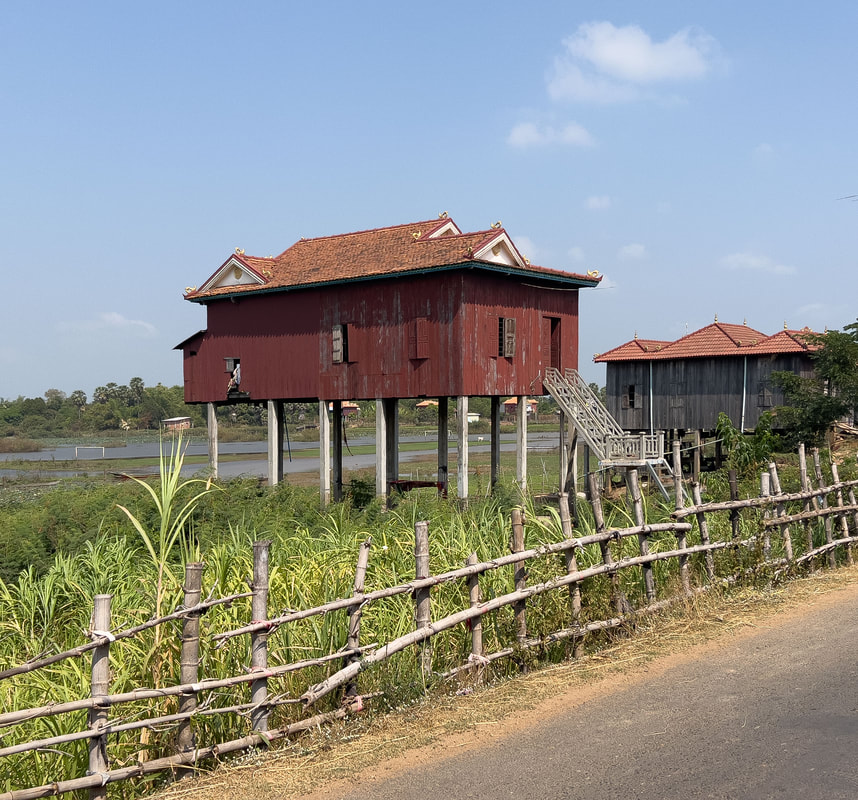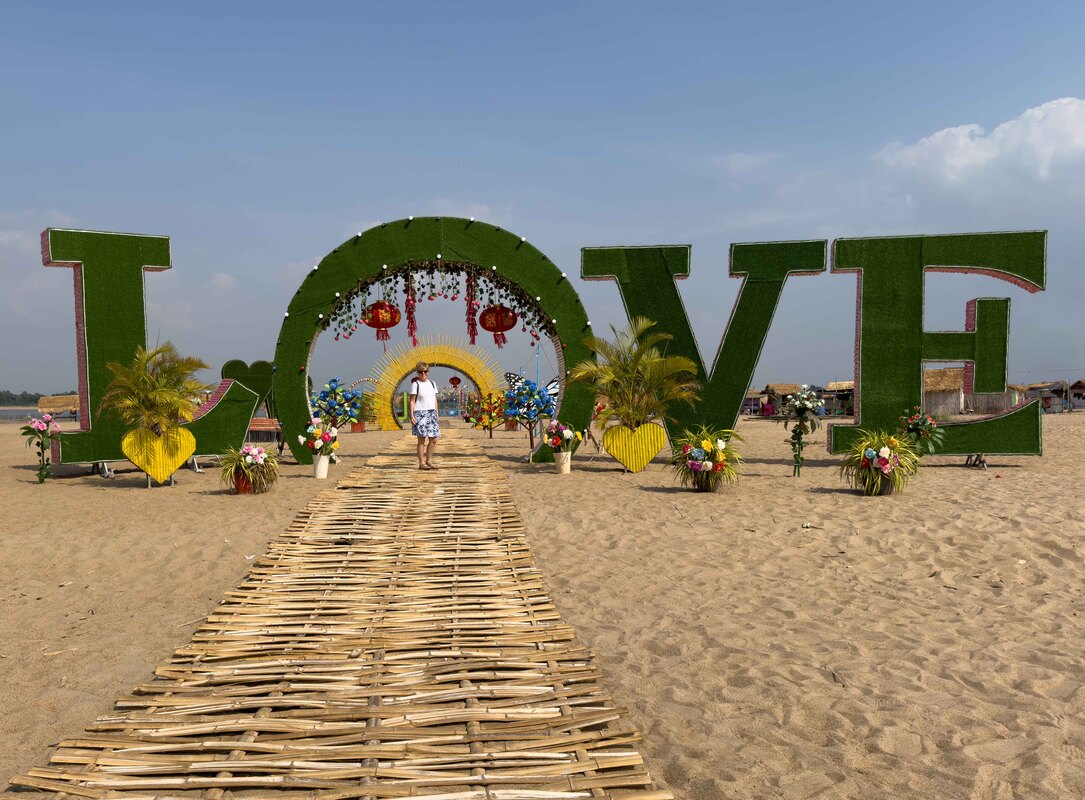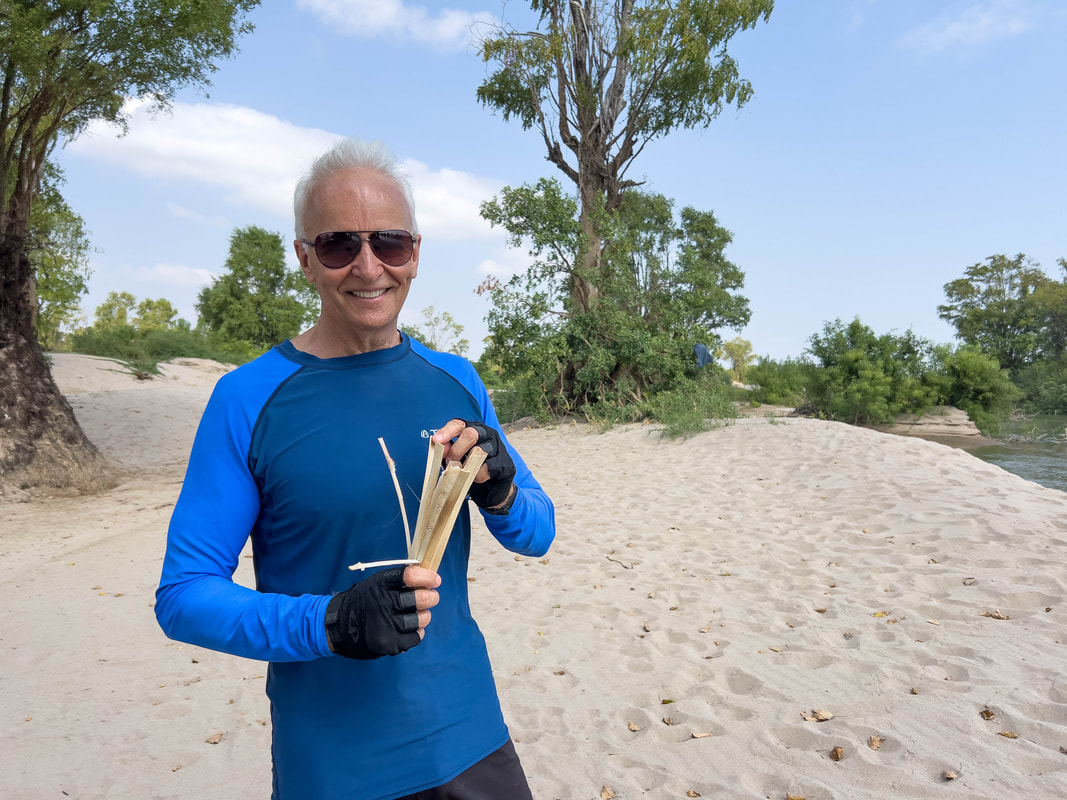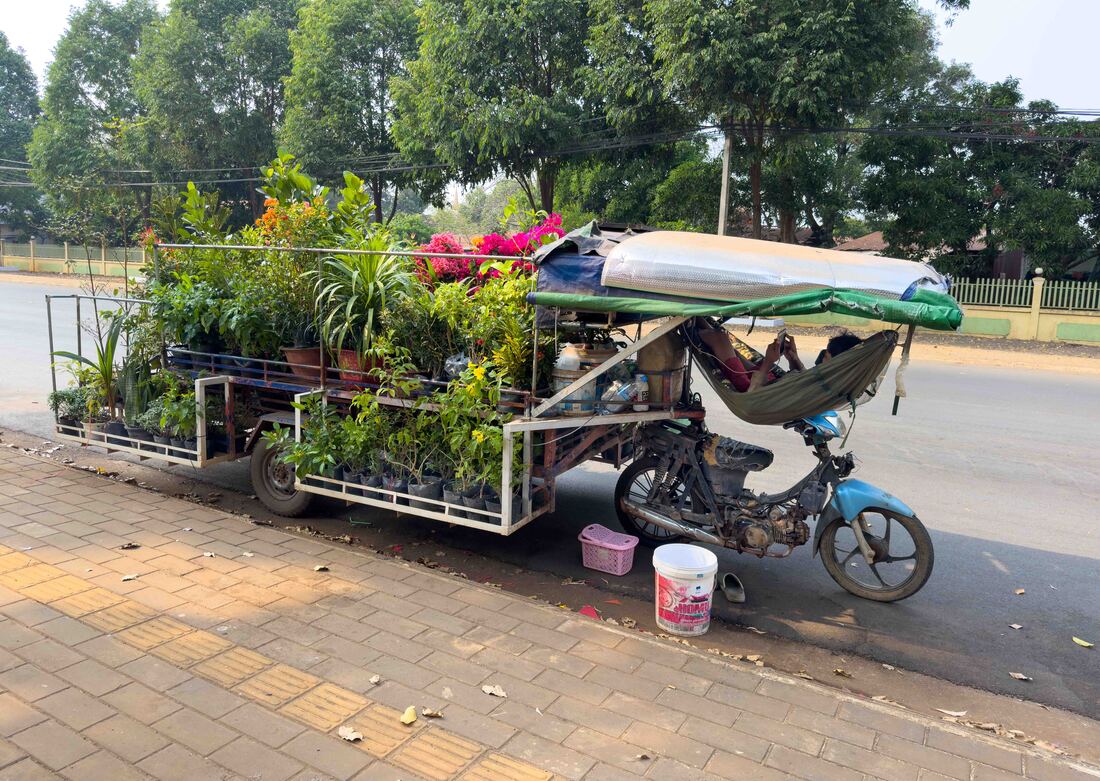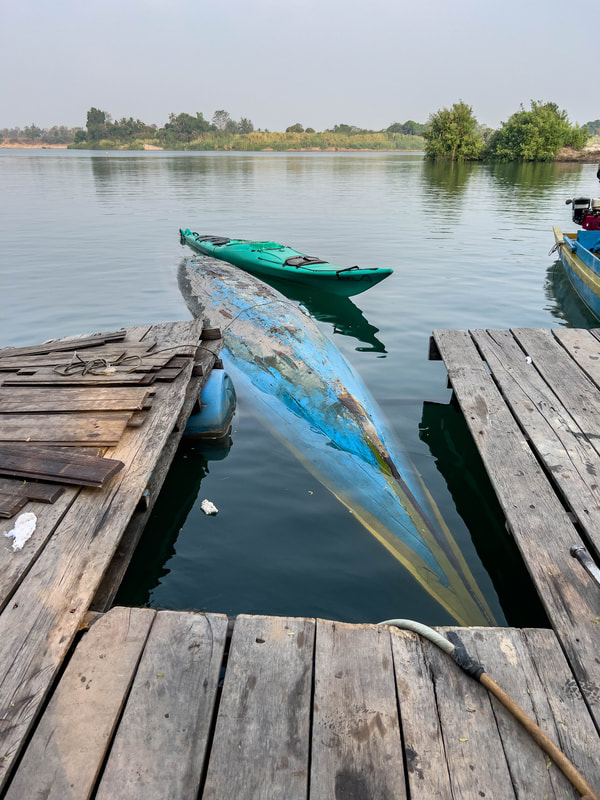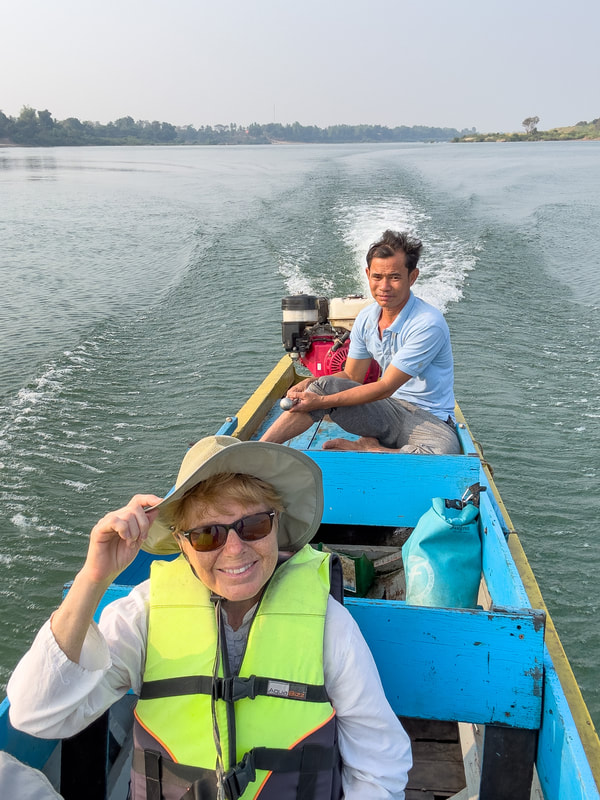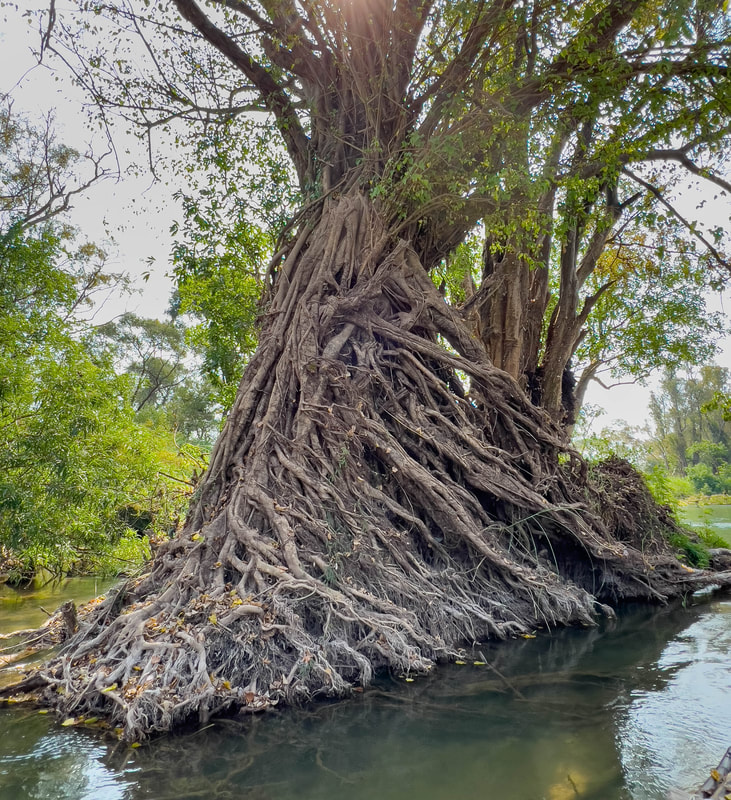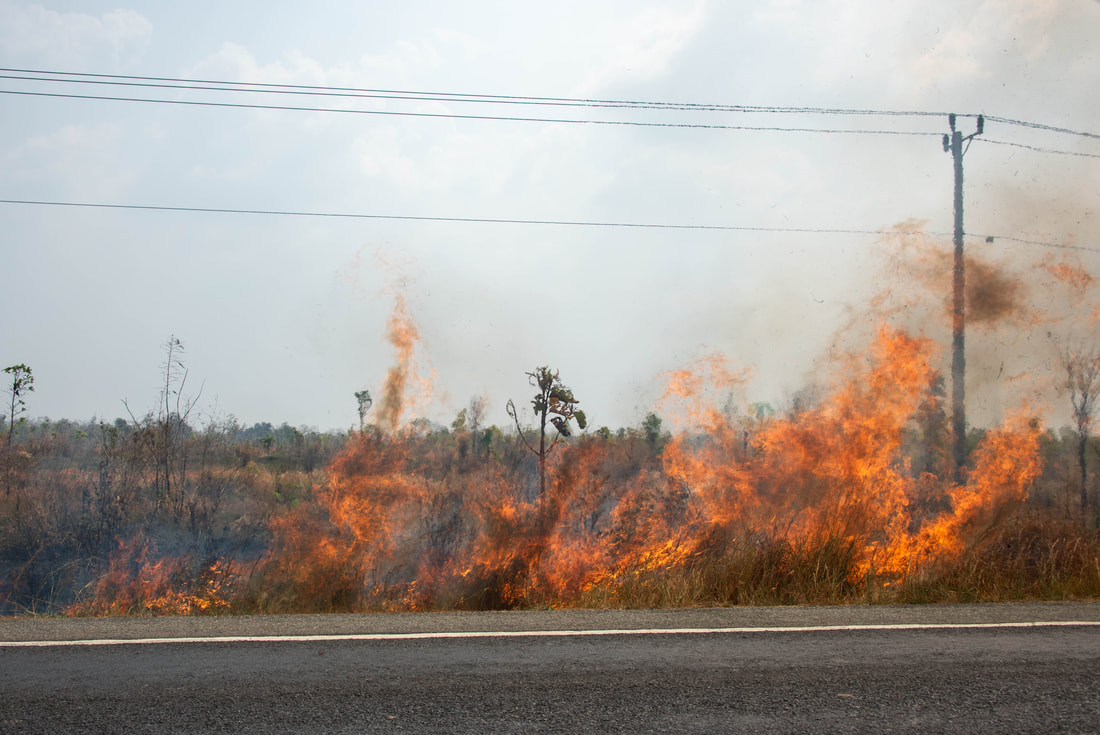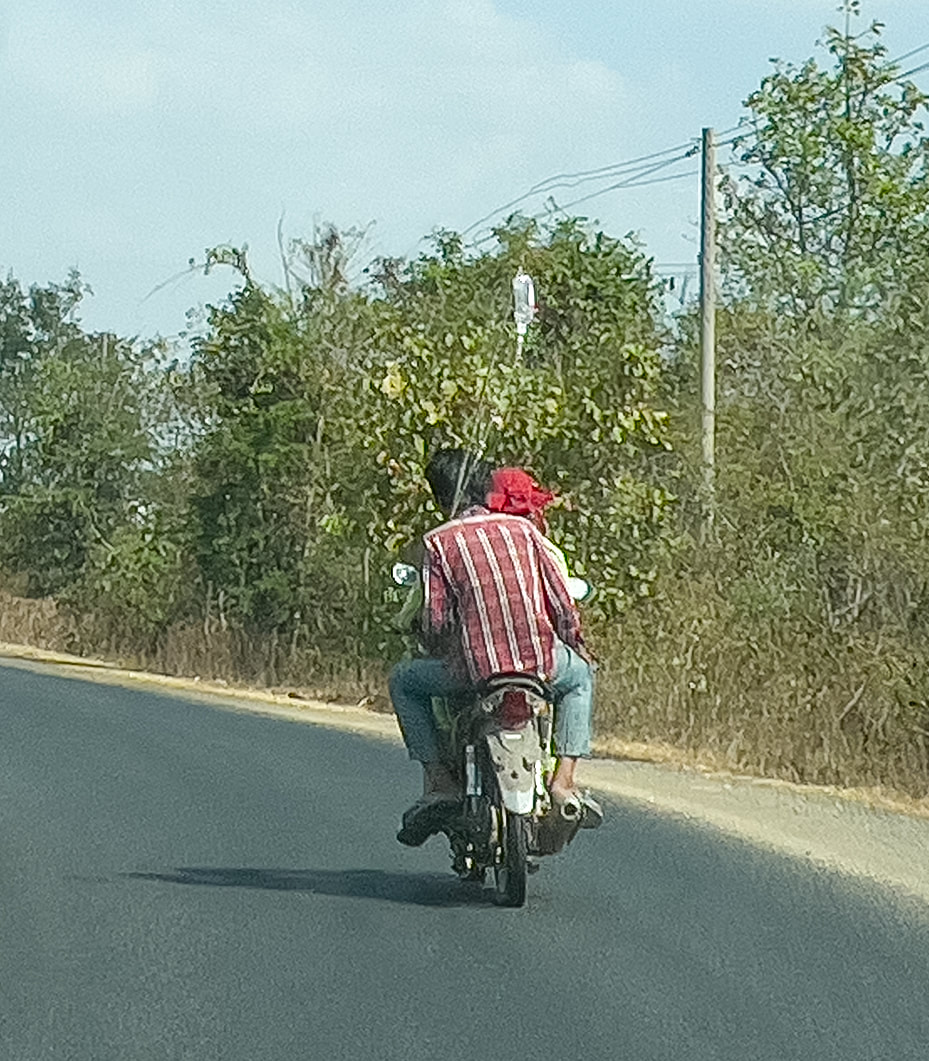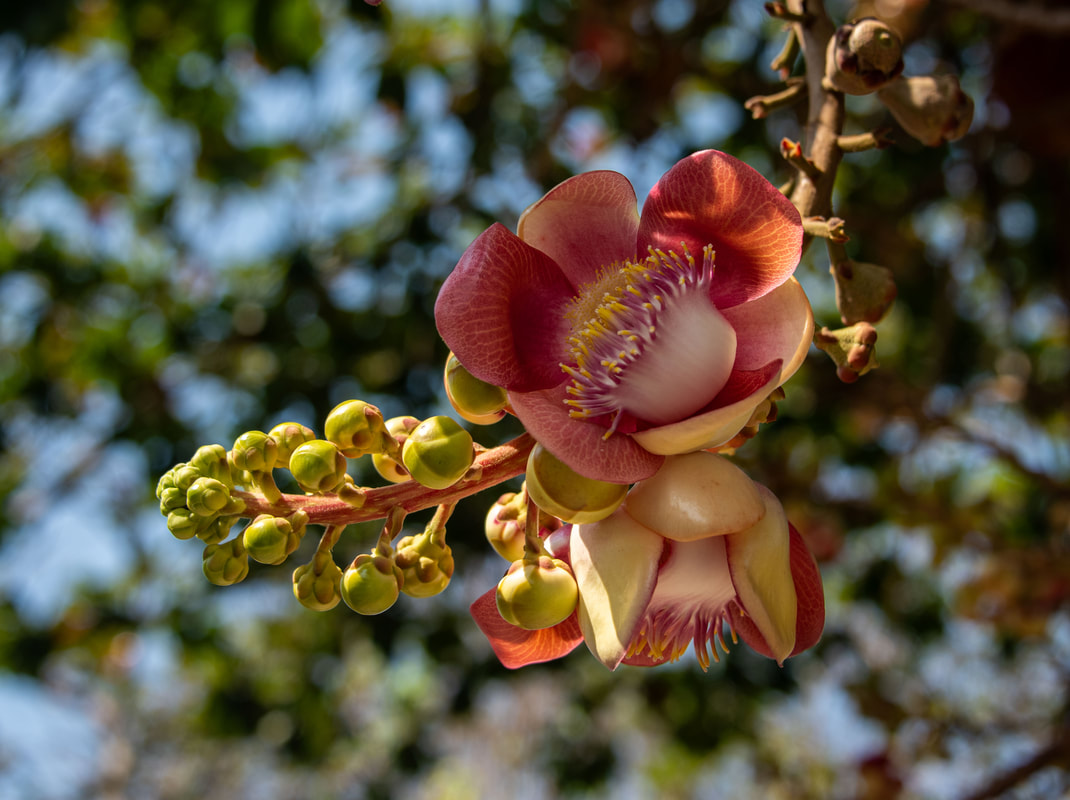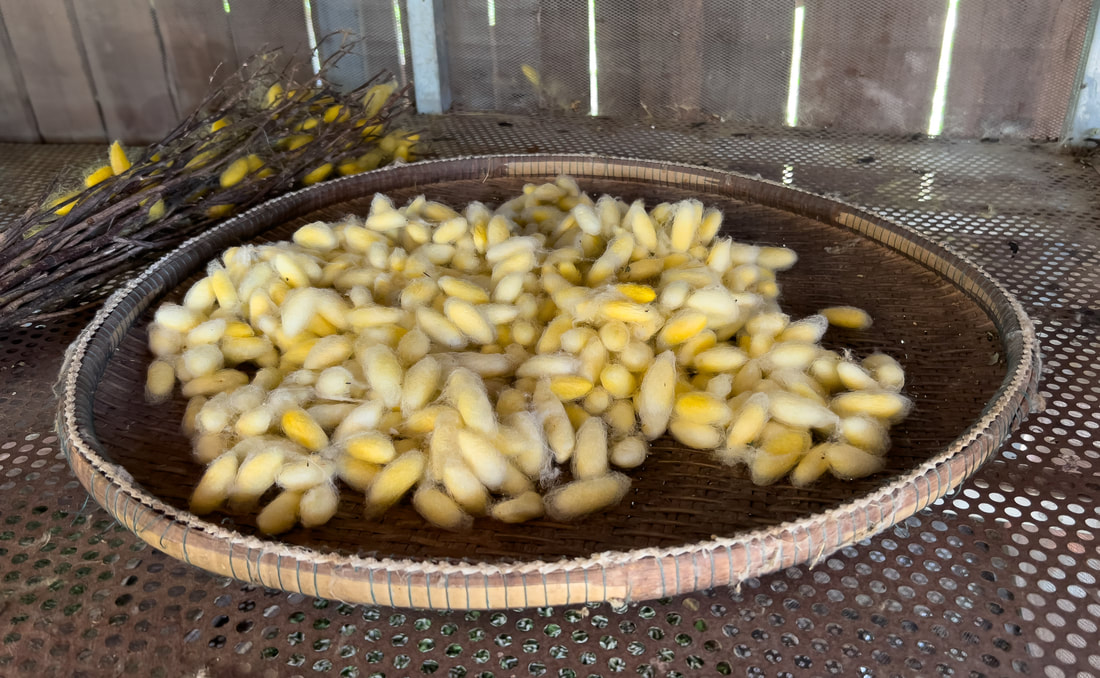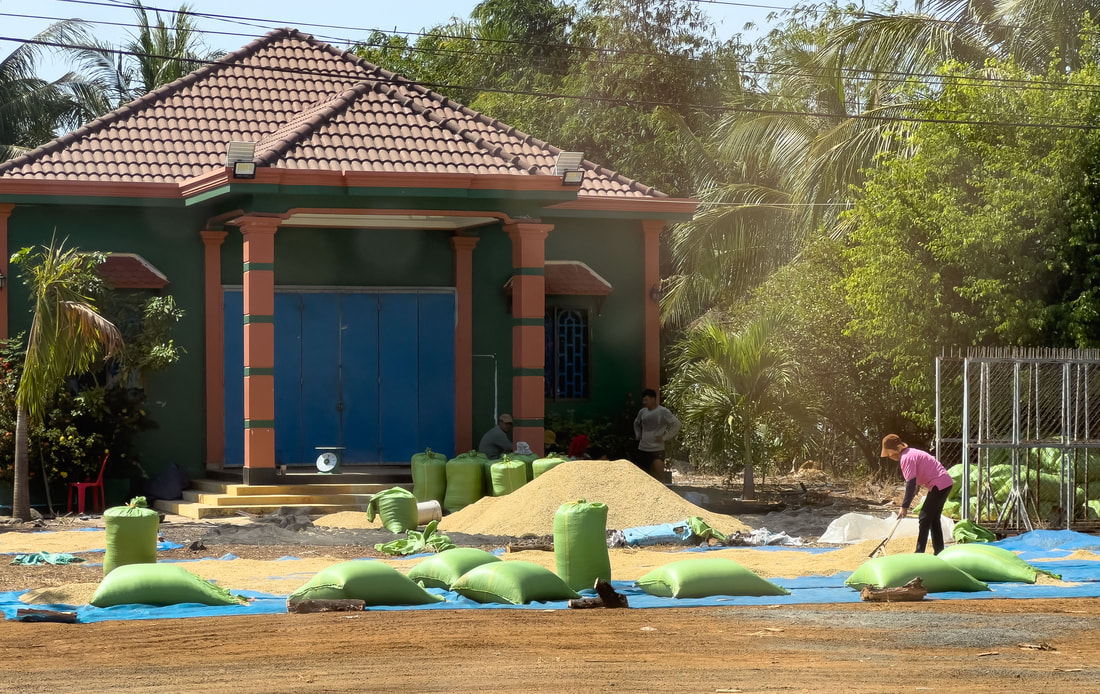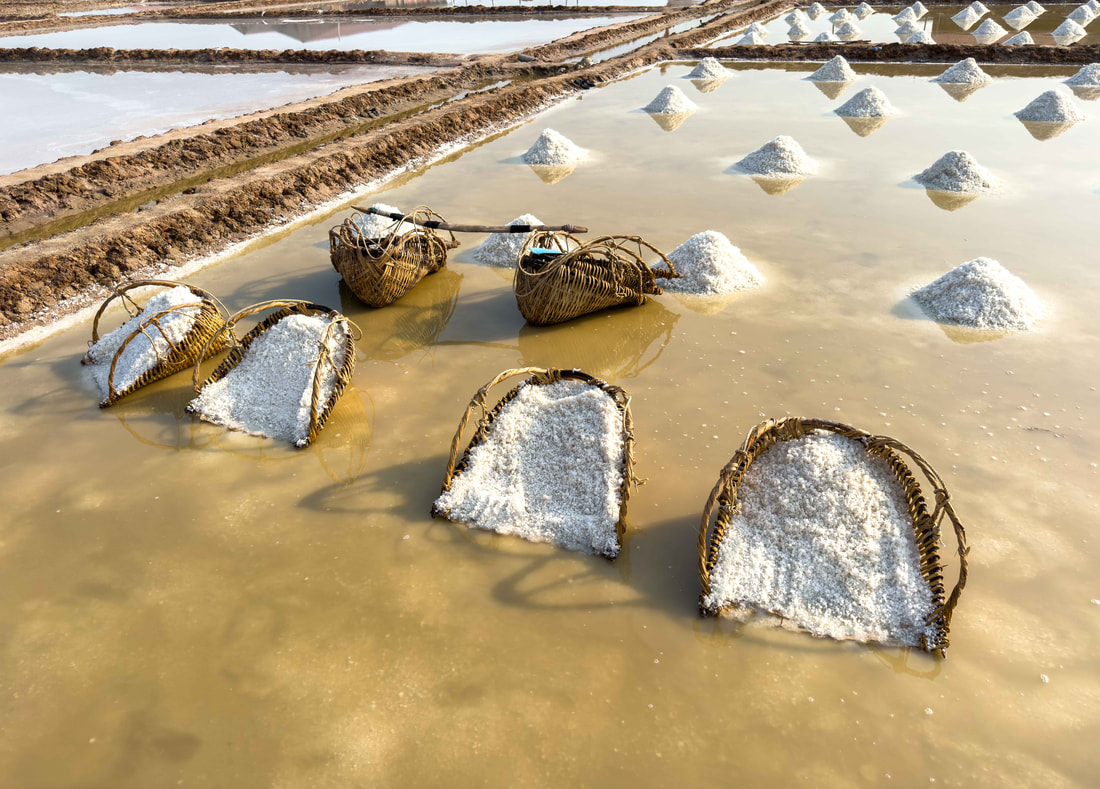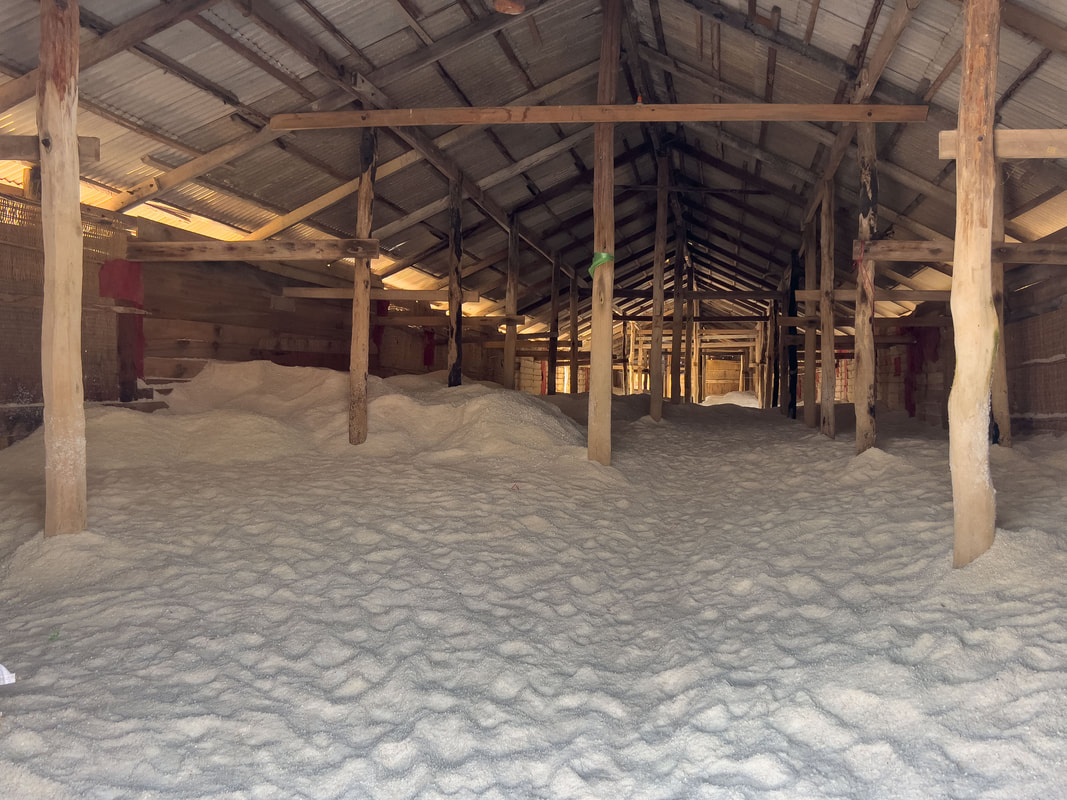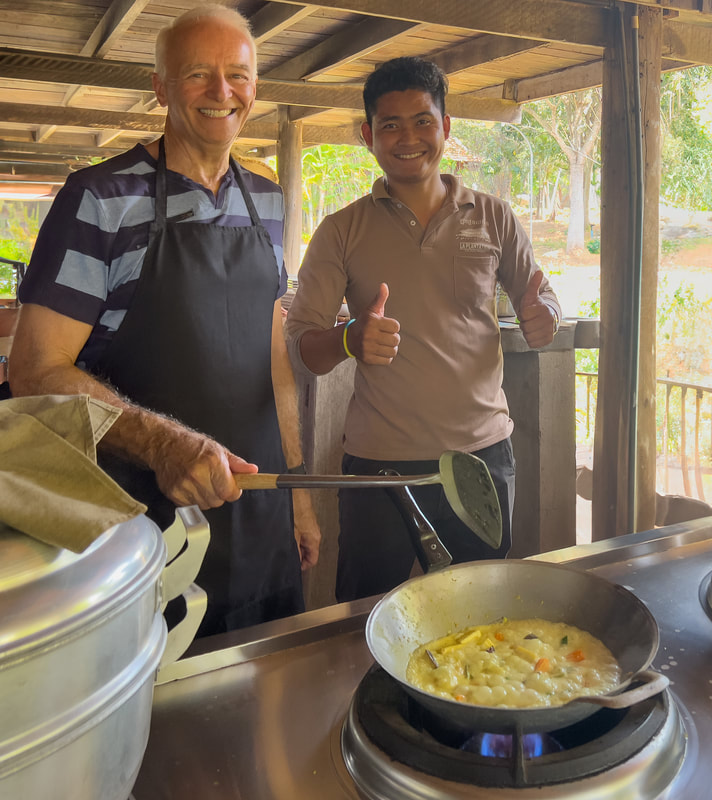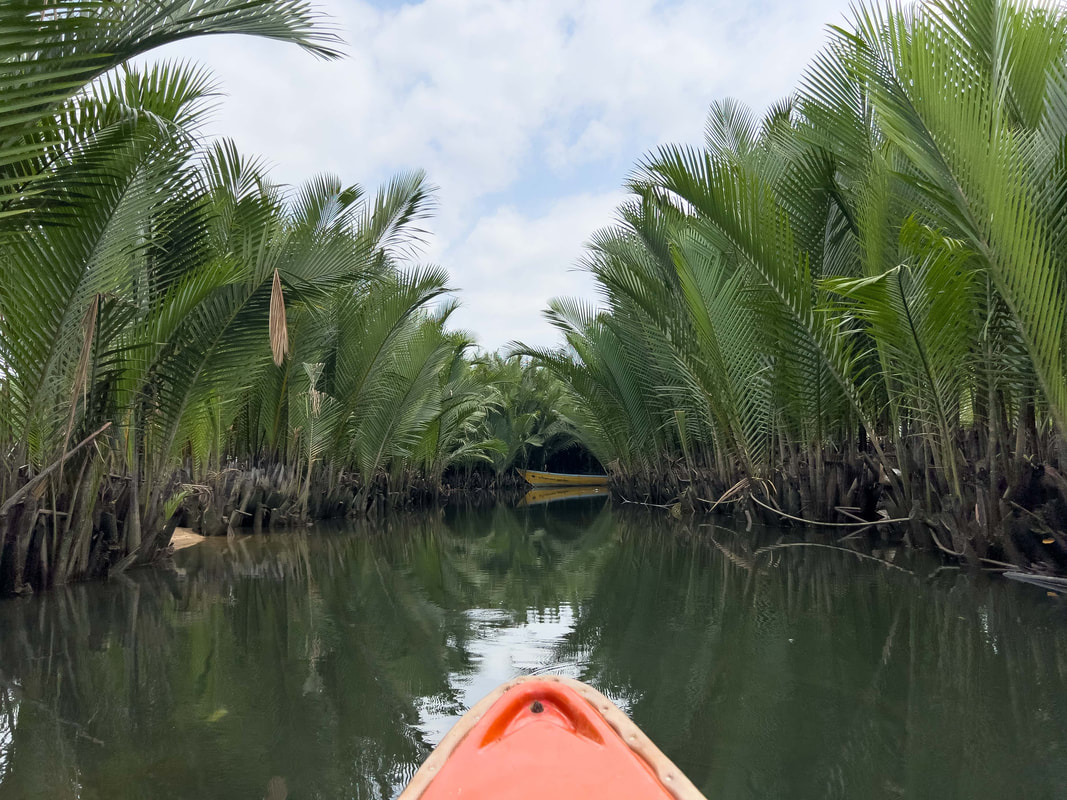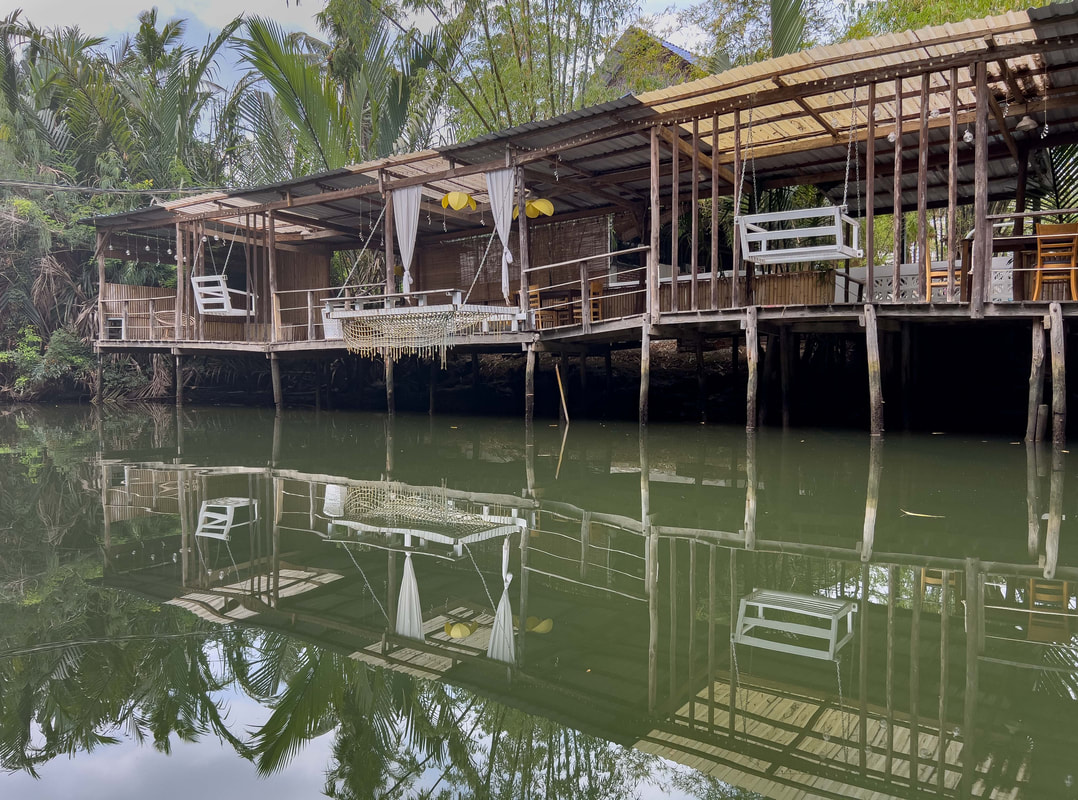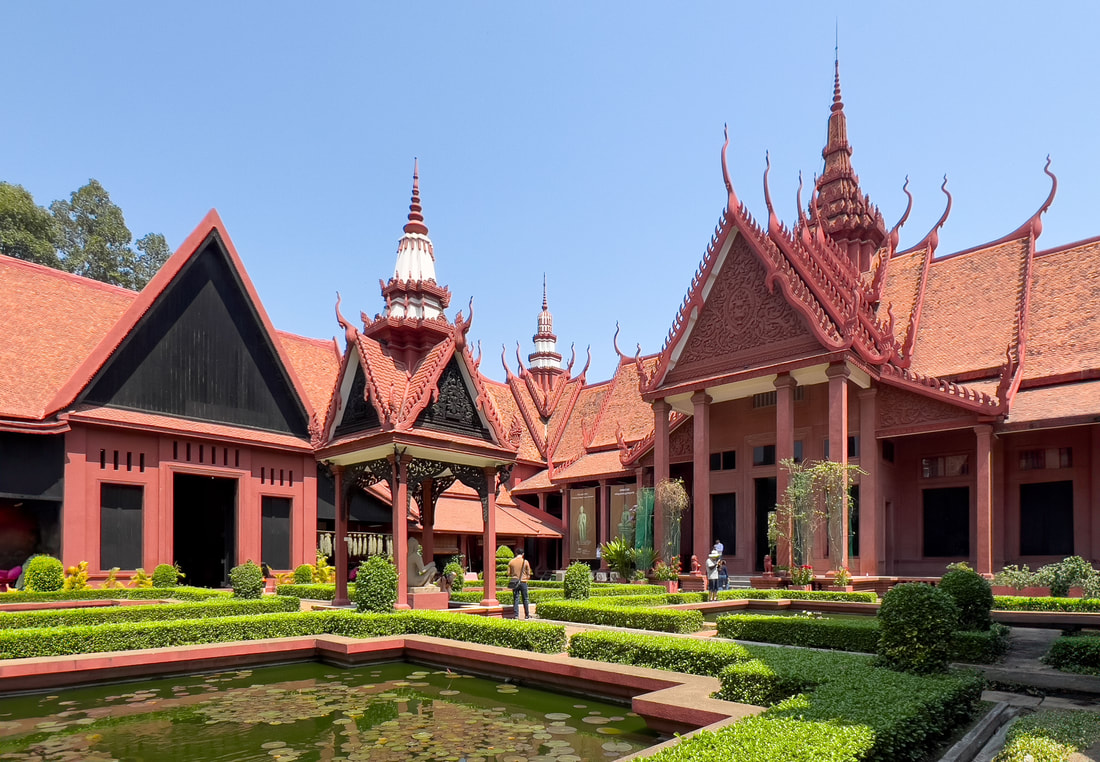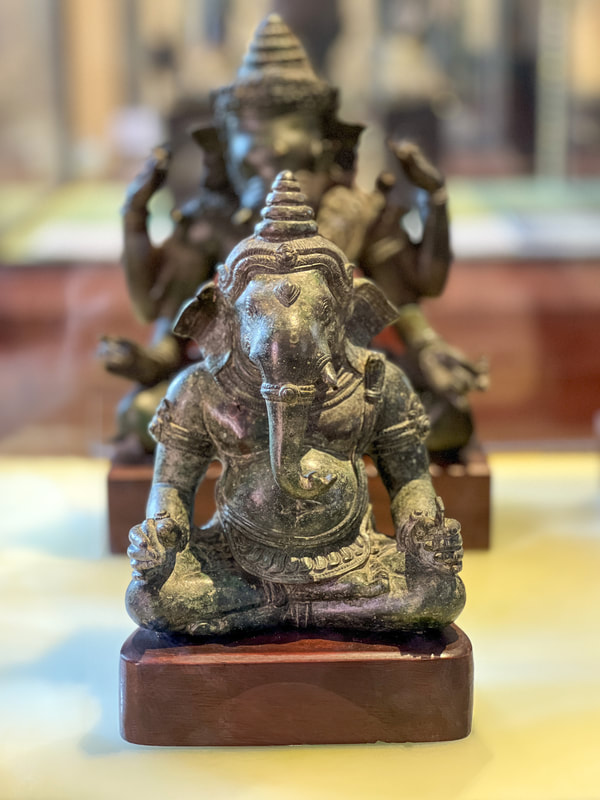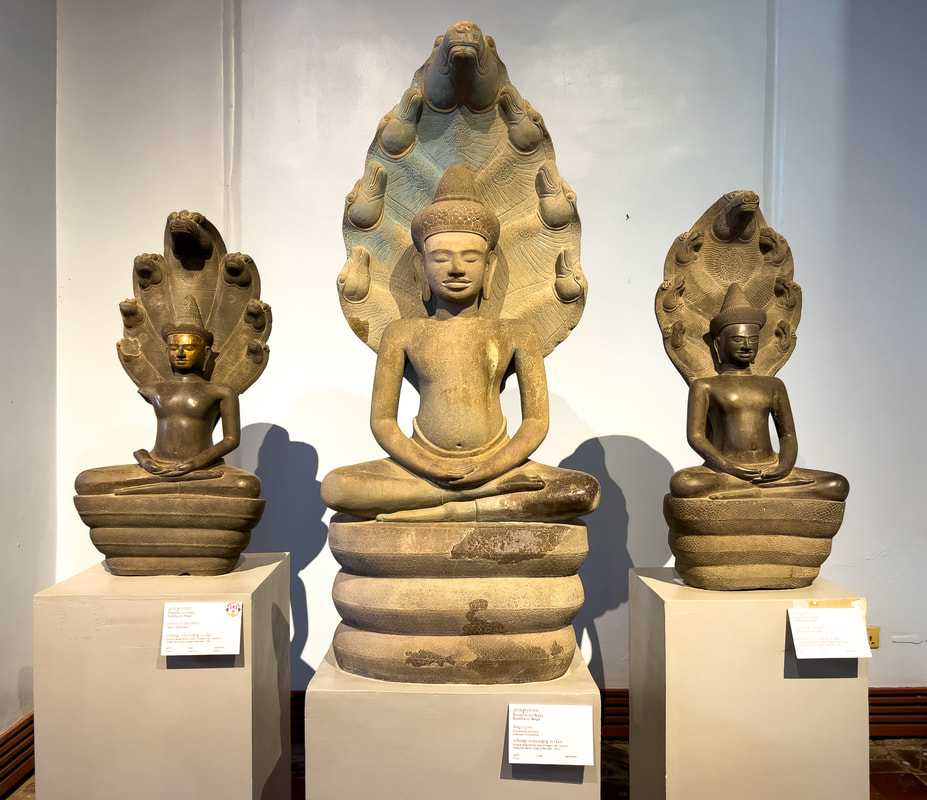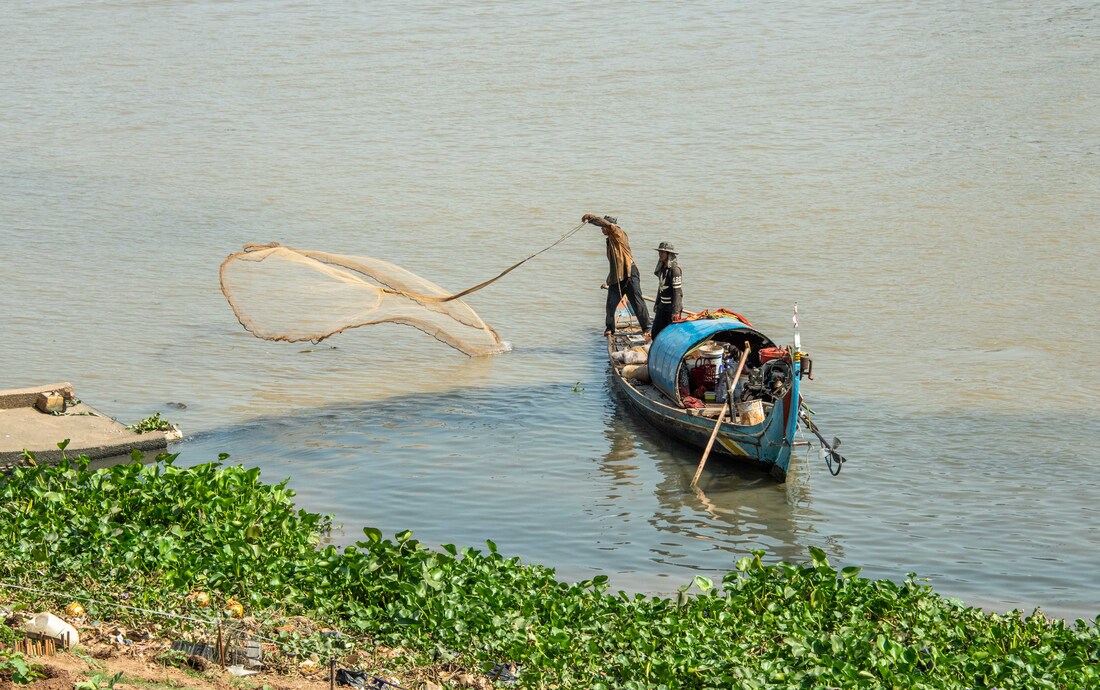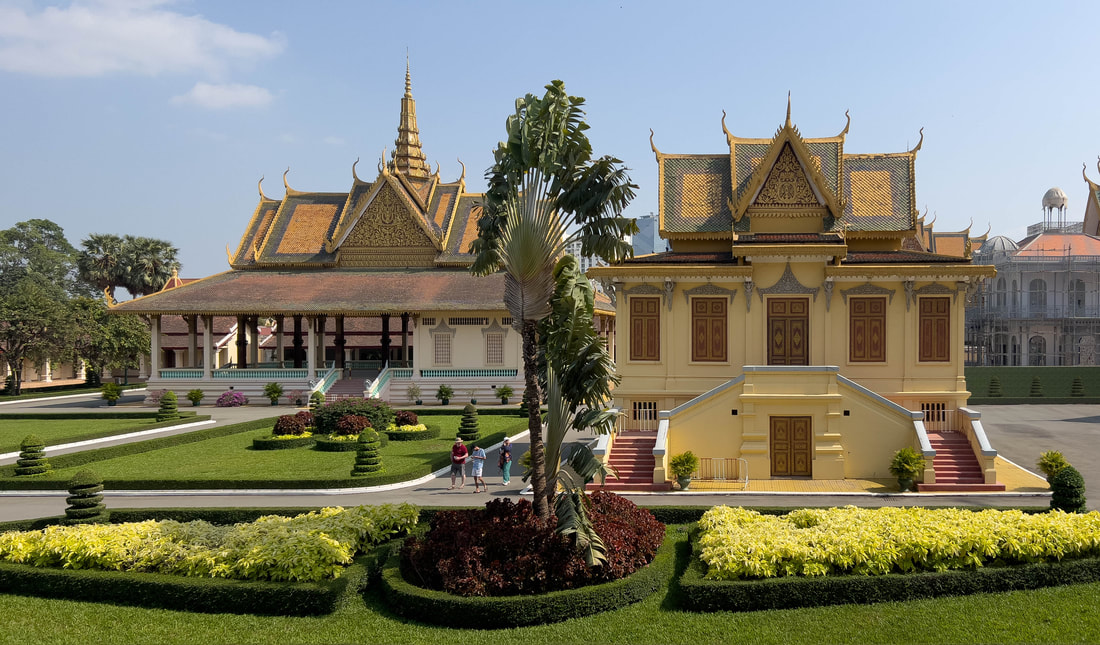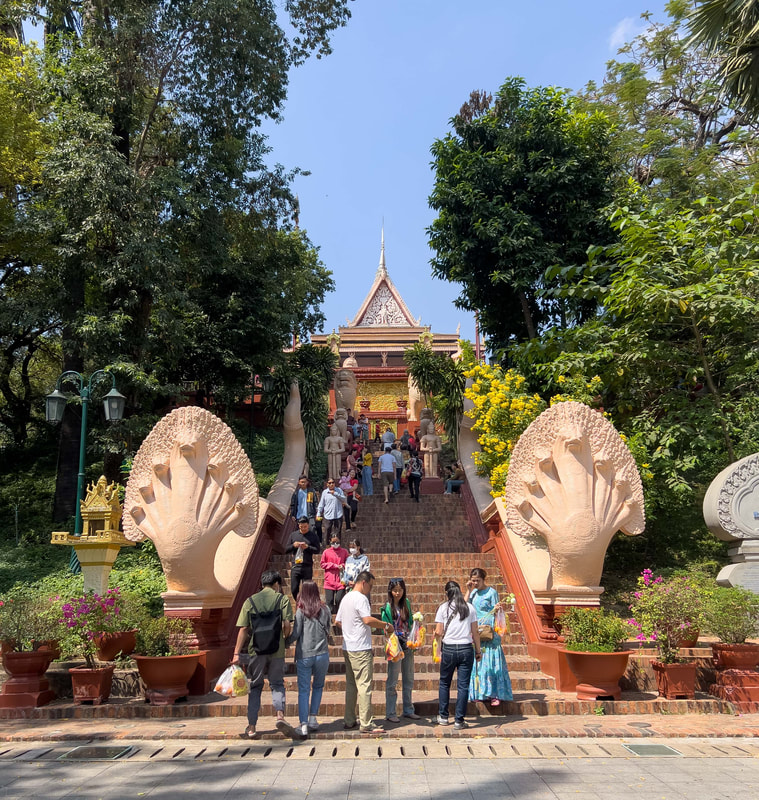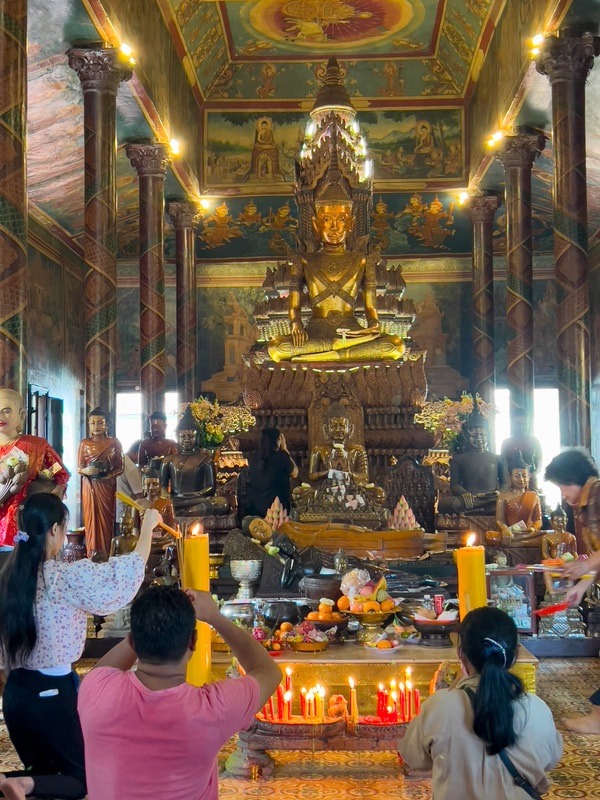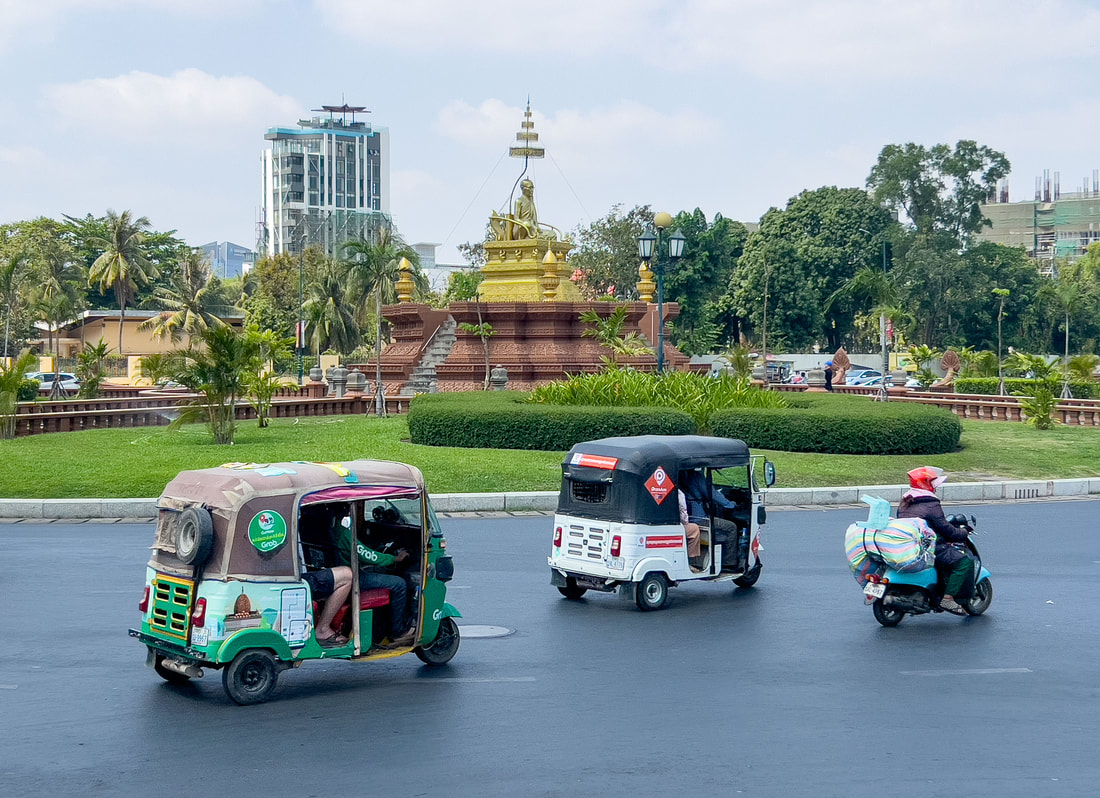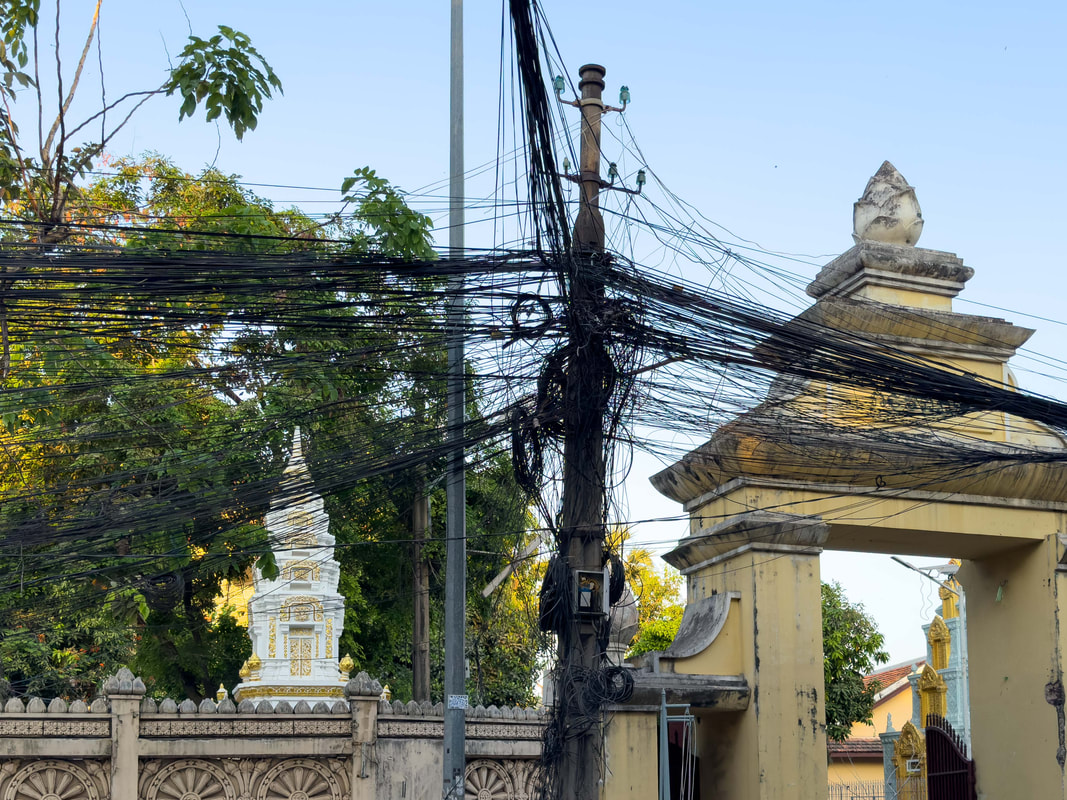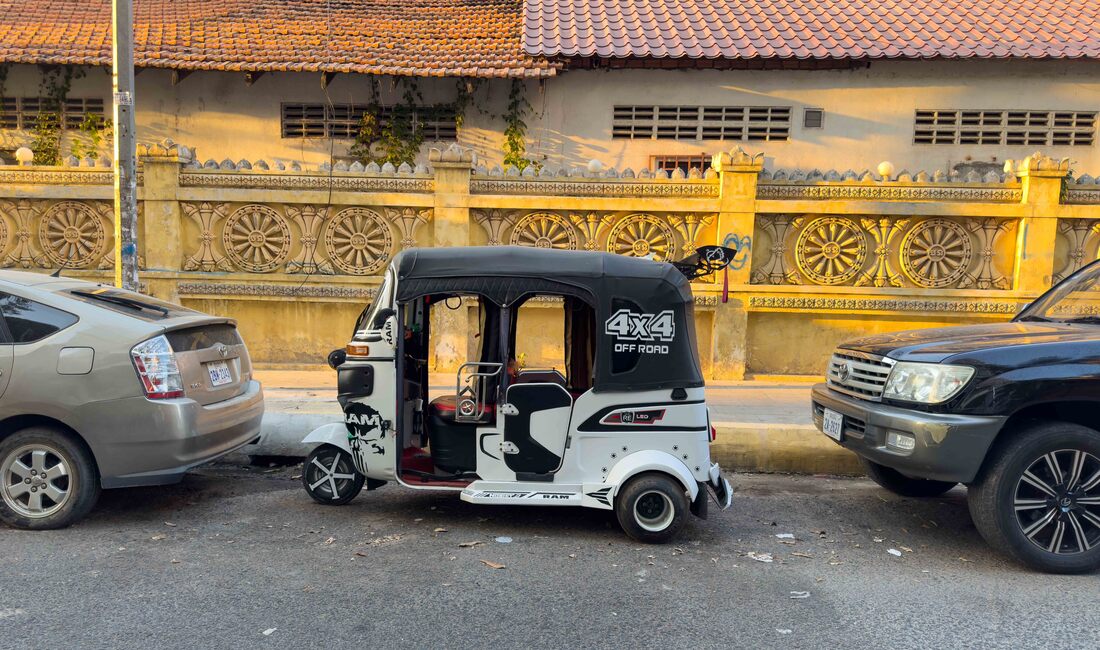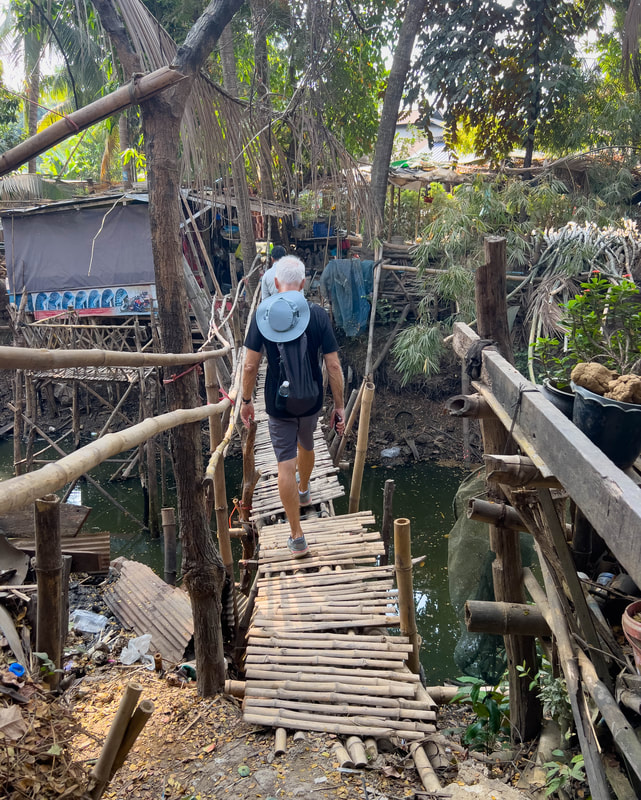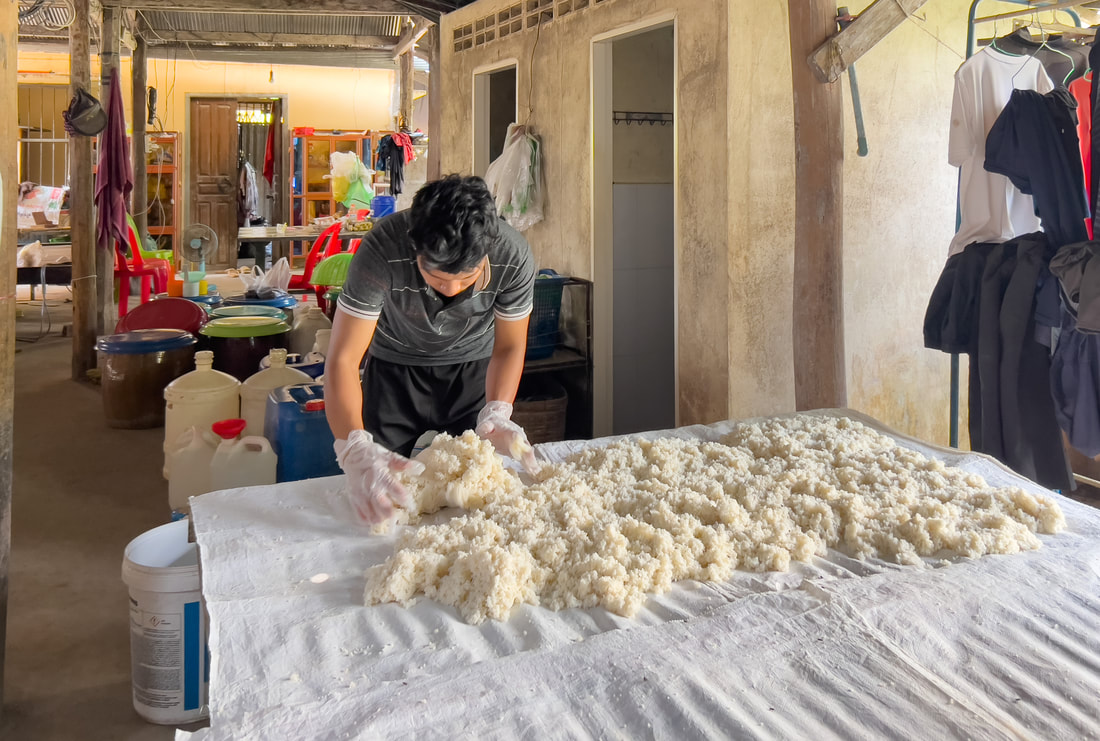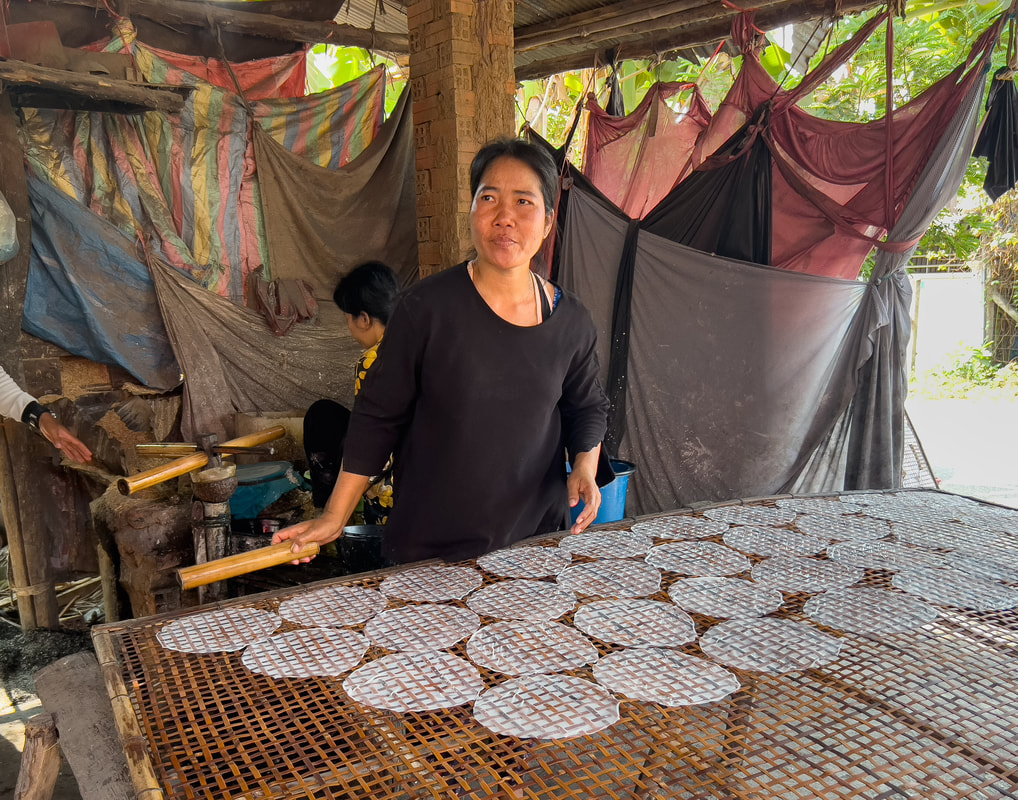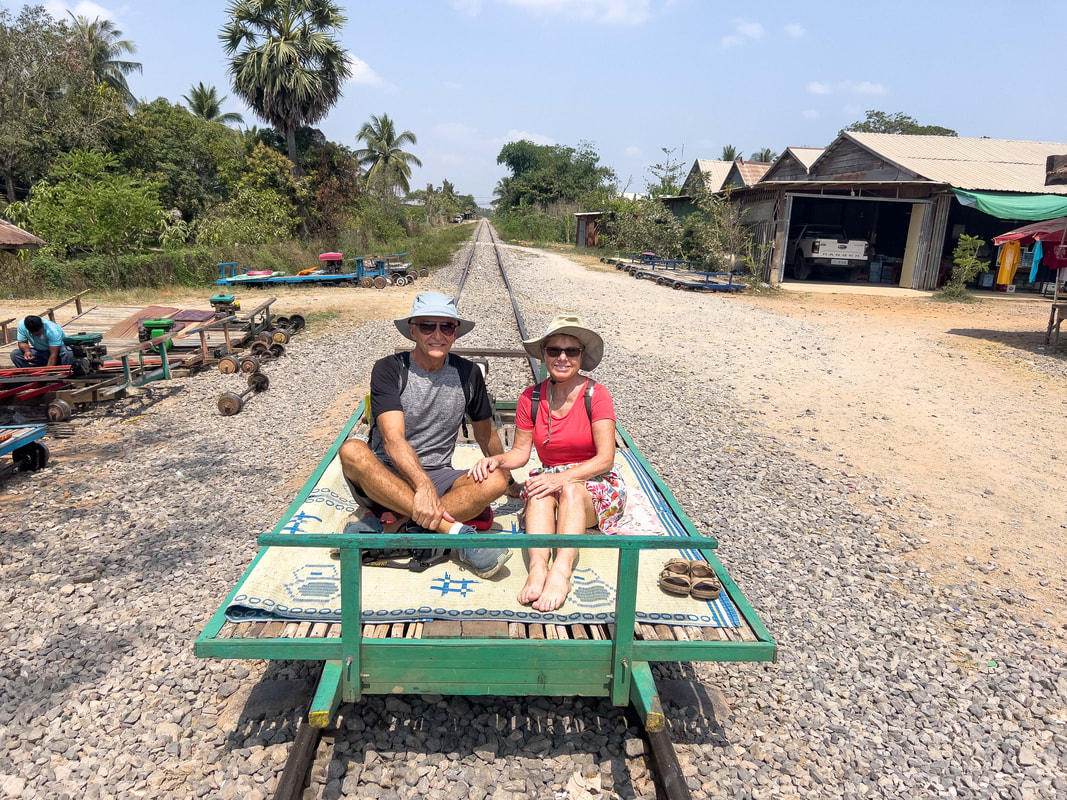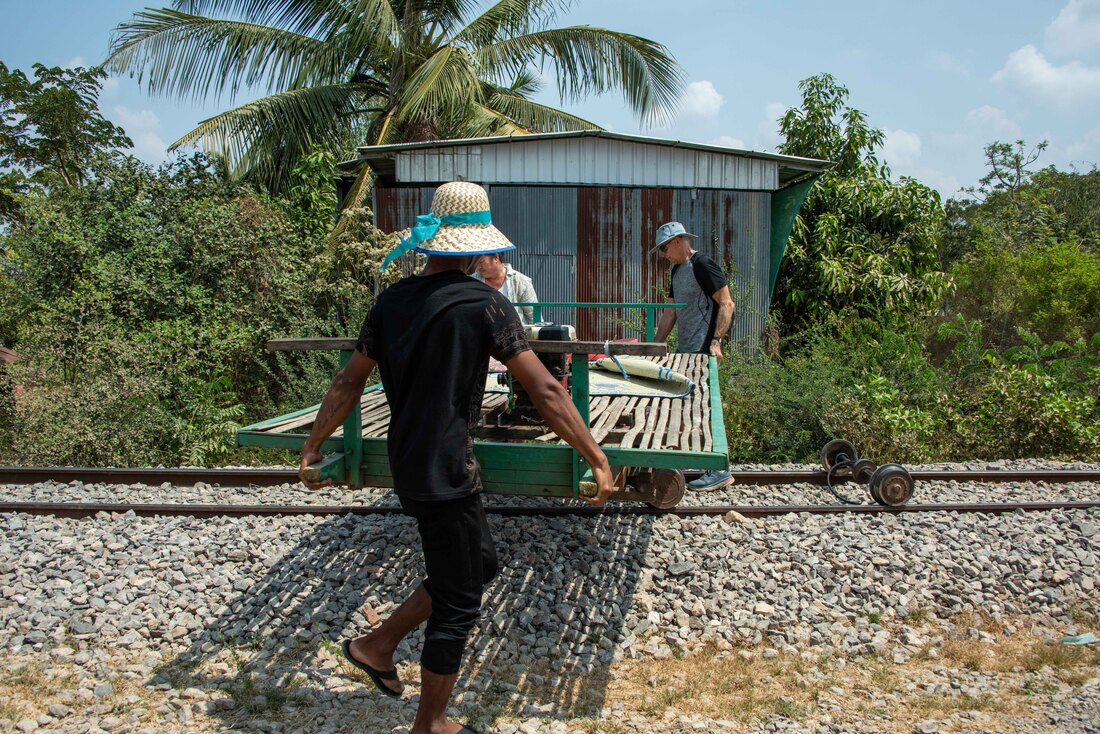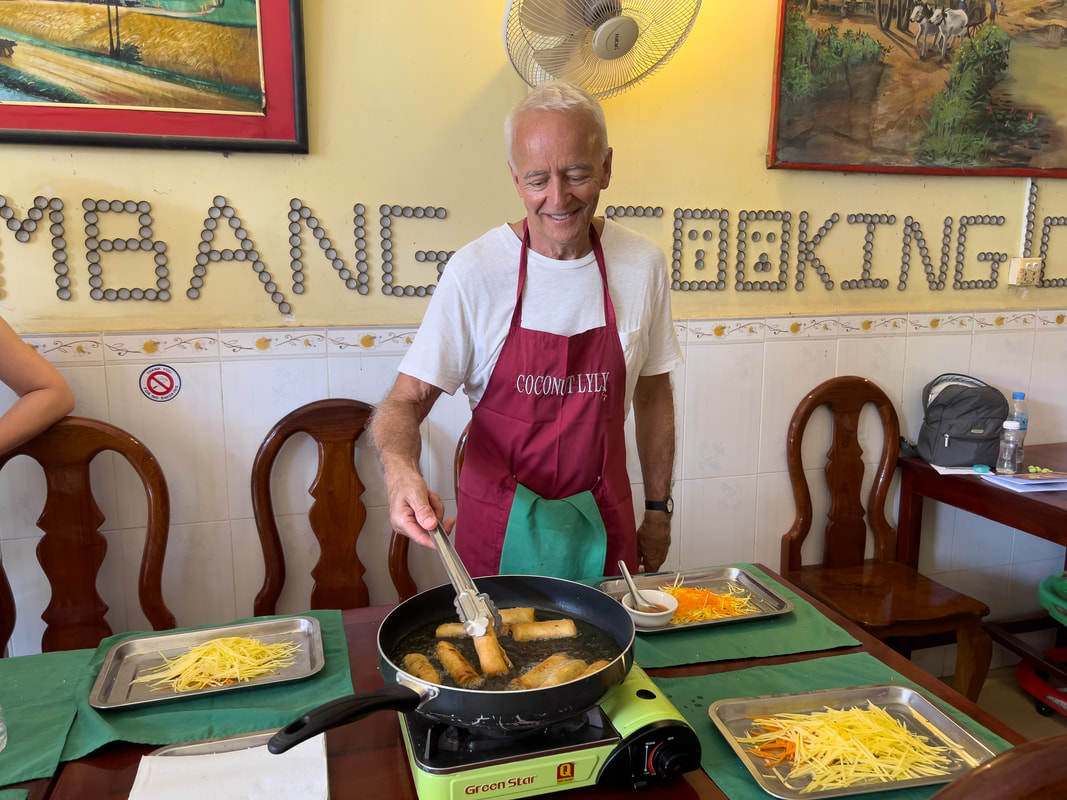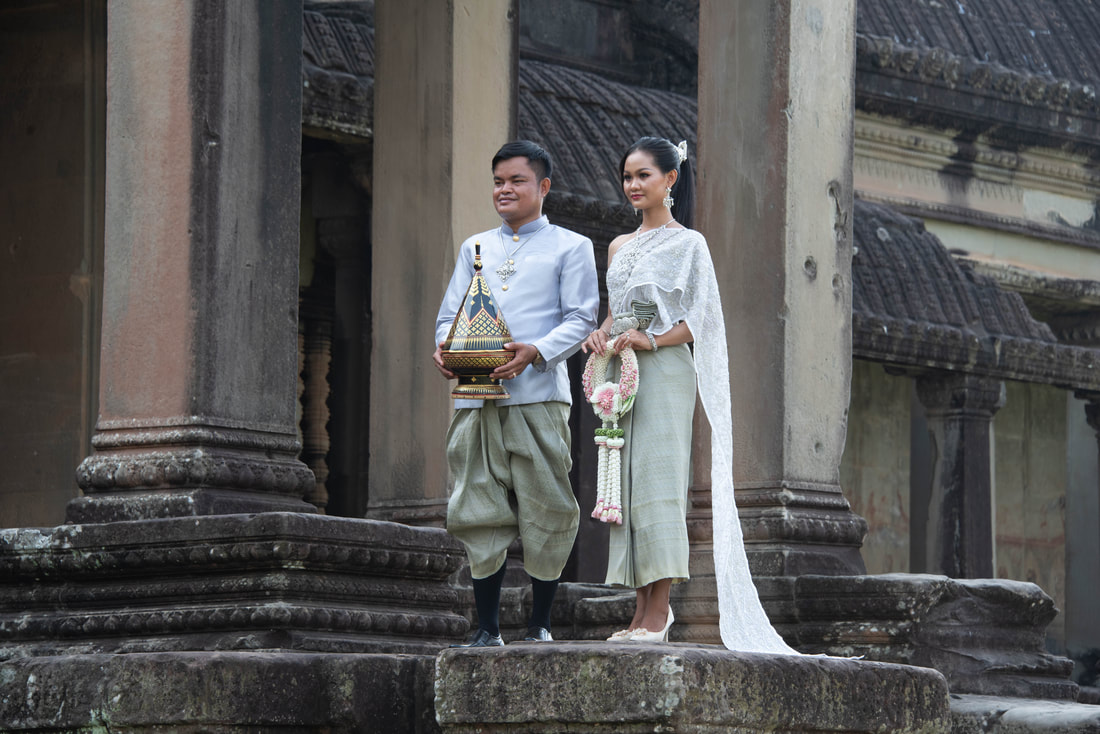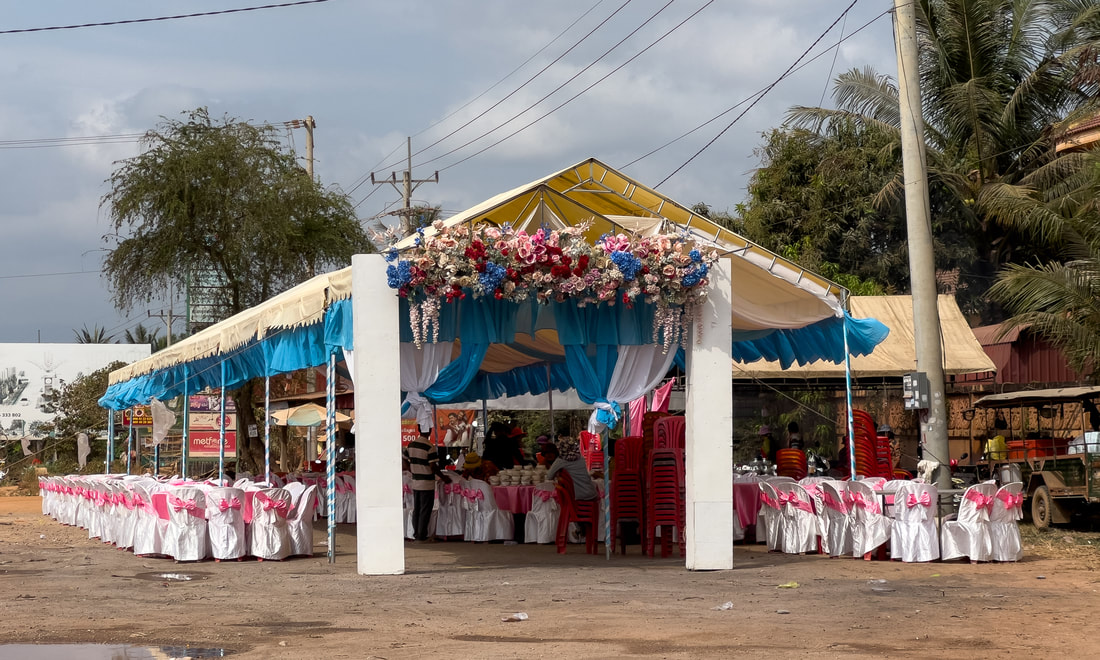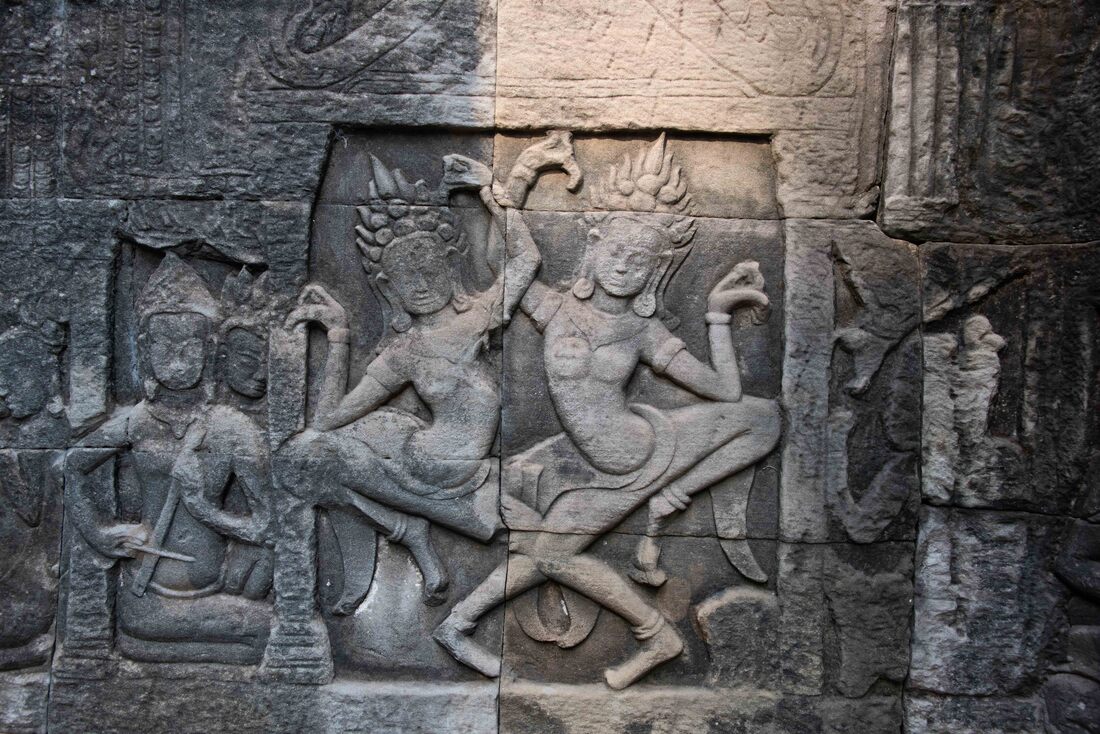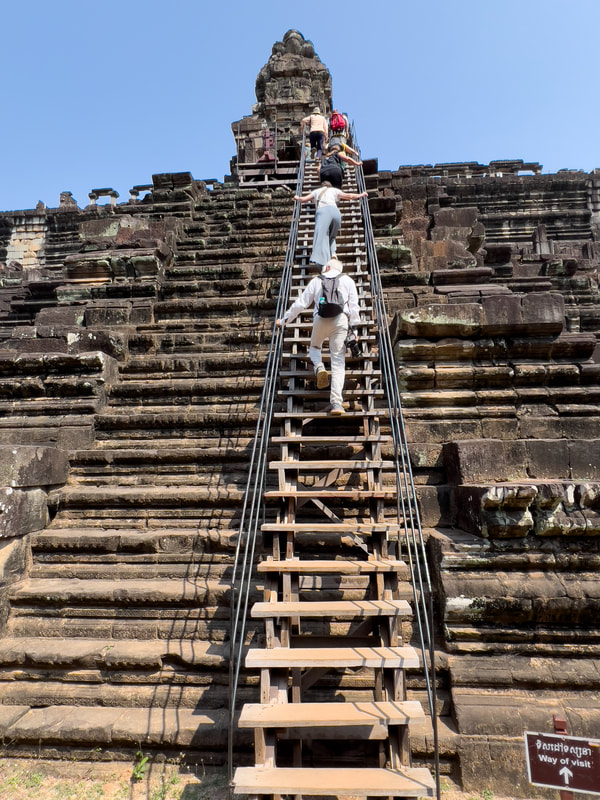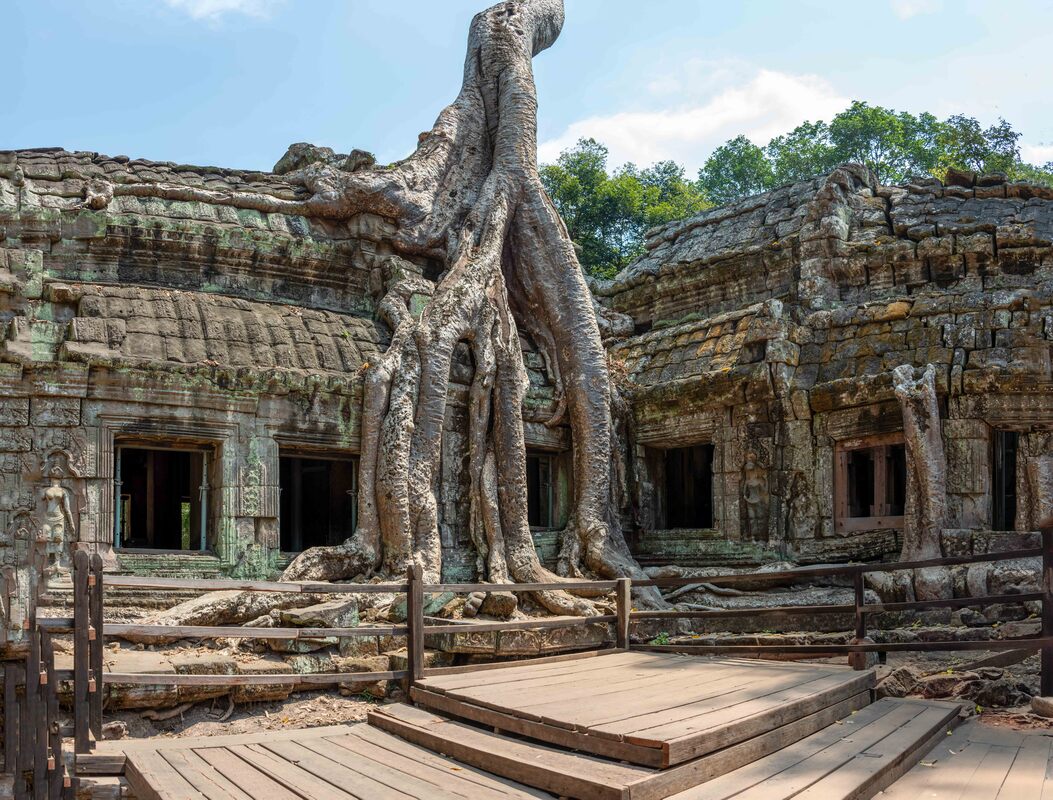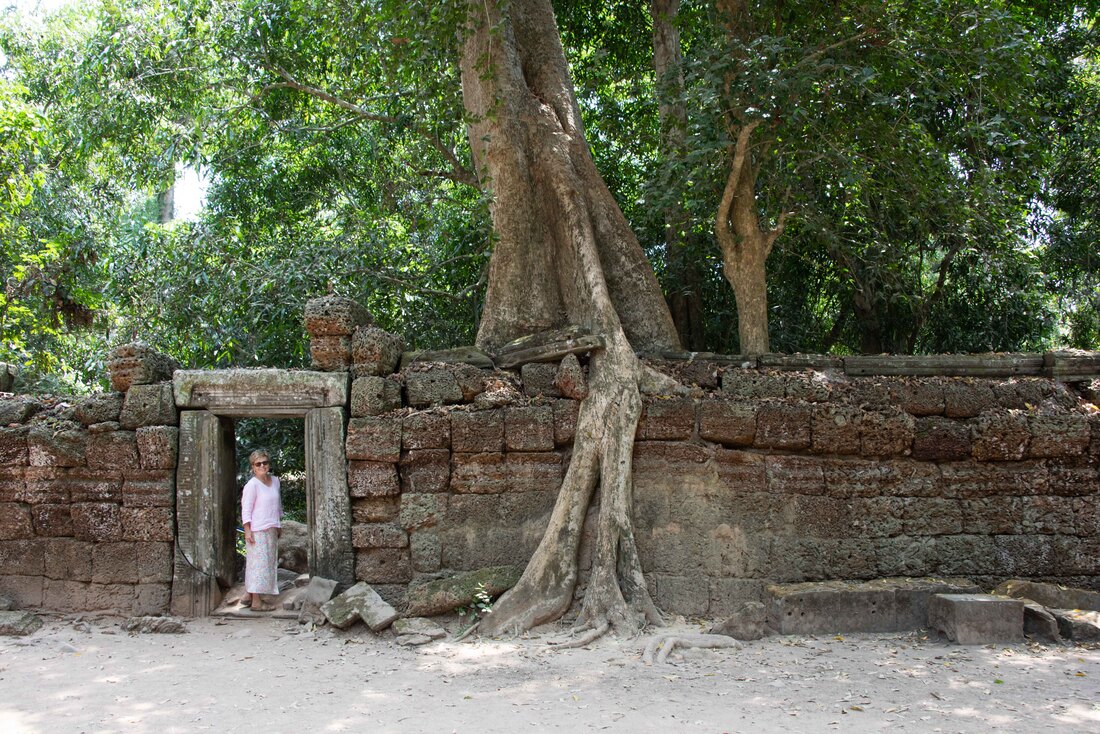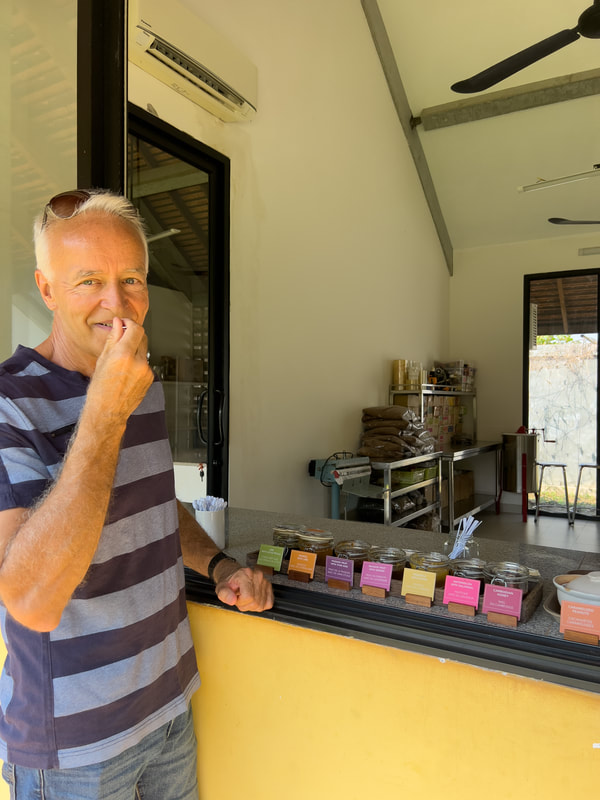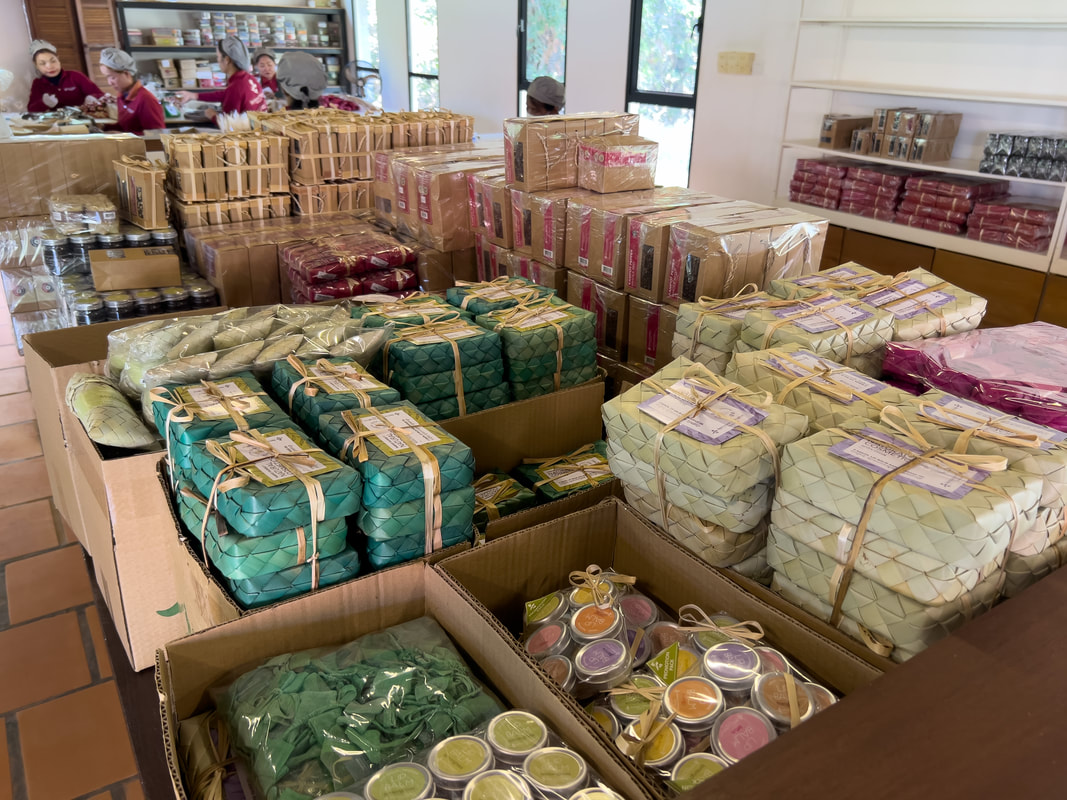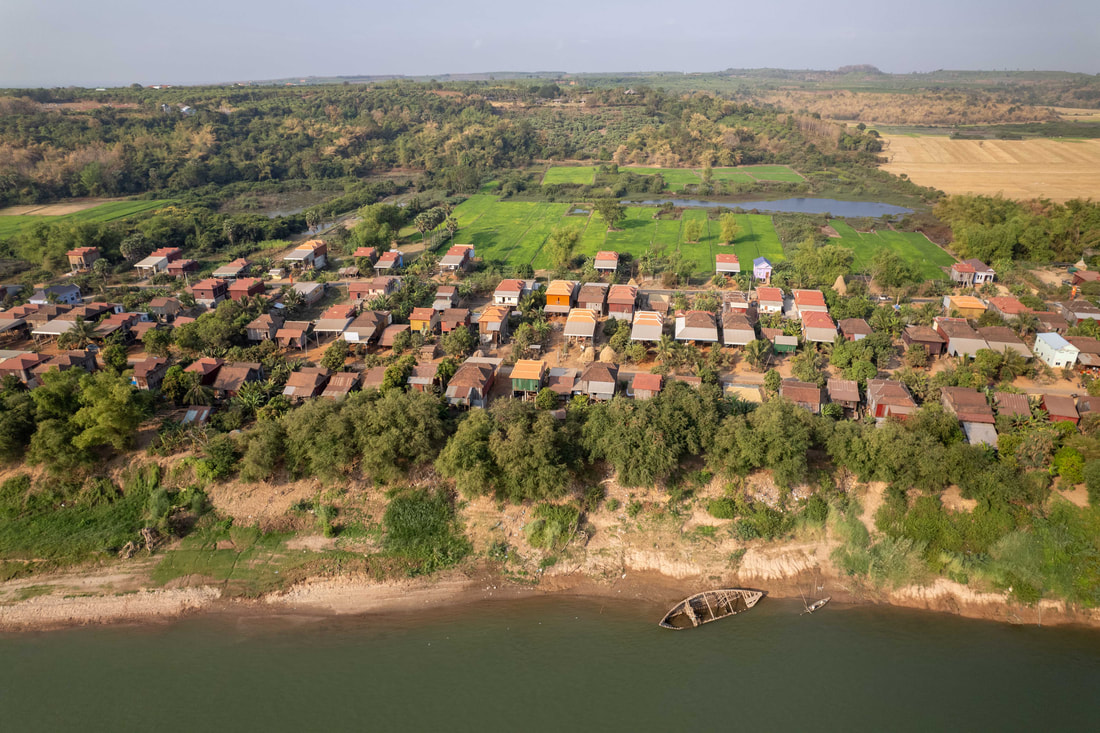
After driving our rental car out of the Phnom Penh airport, it wasn’t long before we were in the less visited northern countryside. Much of the potholed road paralleled the Mekong River as it passed through a series of small villages. Rice paddies and small plots of farmland dotted the landscape. Because this is the dry season much of the rice has recently been harvested, leaving brown fields.
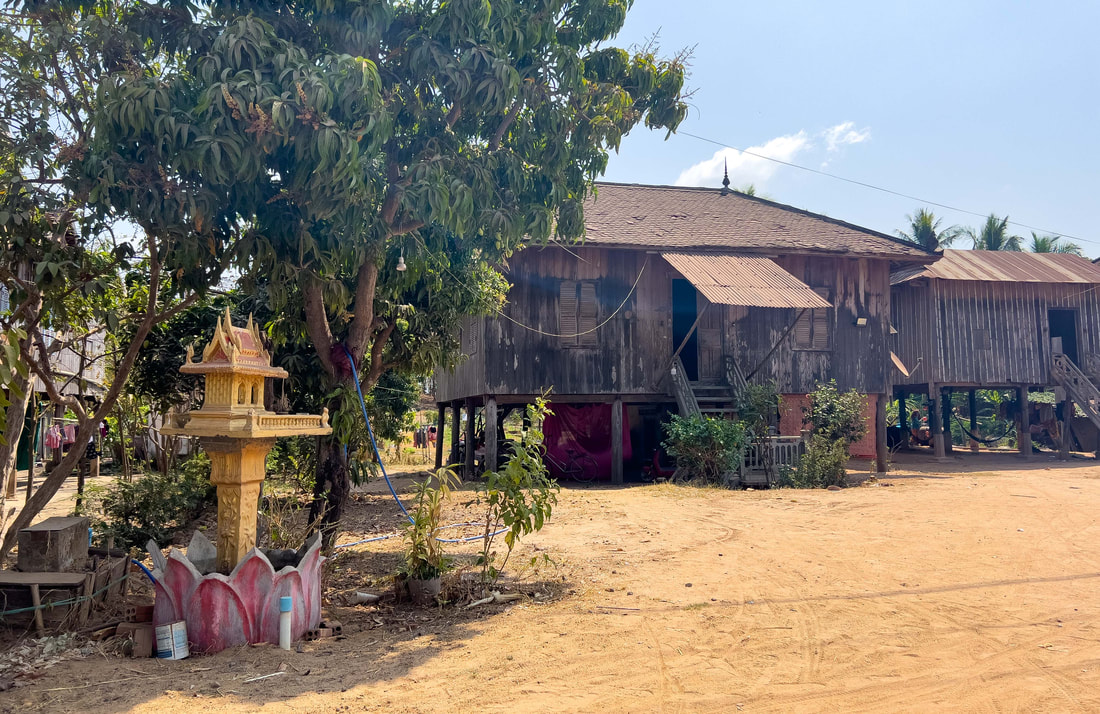
Over 90% of Cambodians are Buddhist. Almost all homes (and even temples) have a spirit house or small shrine placed in the front yard with the shrine door facing the house. They believe this brings luck and wealth to the family. The shrines were big business – we saw several places selling a large selection of them. Most were gold and ornate, but some of the more rustic homes had DIY plywood versions.
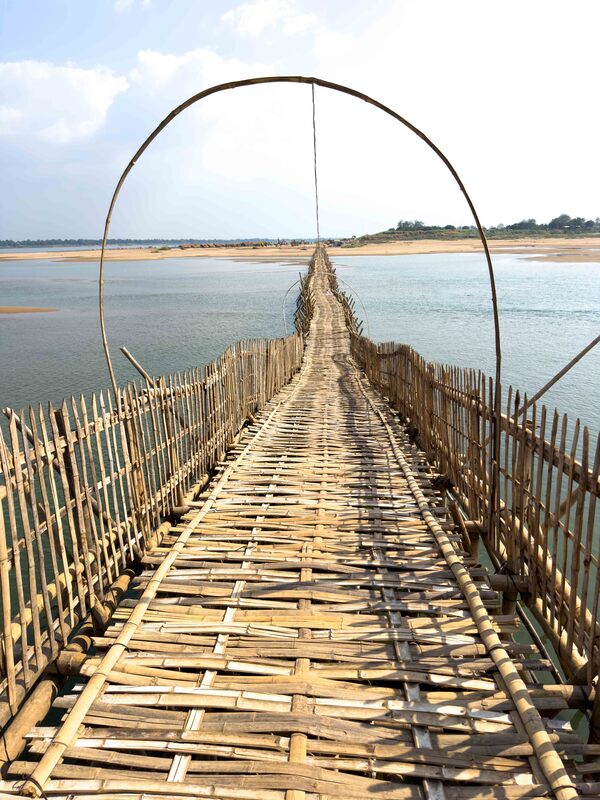
Our first stop on the itinerary was known for it bamboo bridge built across a narrower section of the Mekong to a dry season sandbar. Each year the bridge is flooded and then rebuilt by hand when the water recedes. Walking across it was a creaky, watch your step affair. On the sandbar, colourful decorated paths and places to grab a bite to eat, attracted the young people. Along the cliff overlooking the bridge was a long section of trees shading seats and small eateries for those wanting to people watch. (Kompong Cham, Feb 1-3)
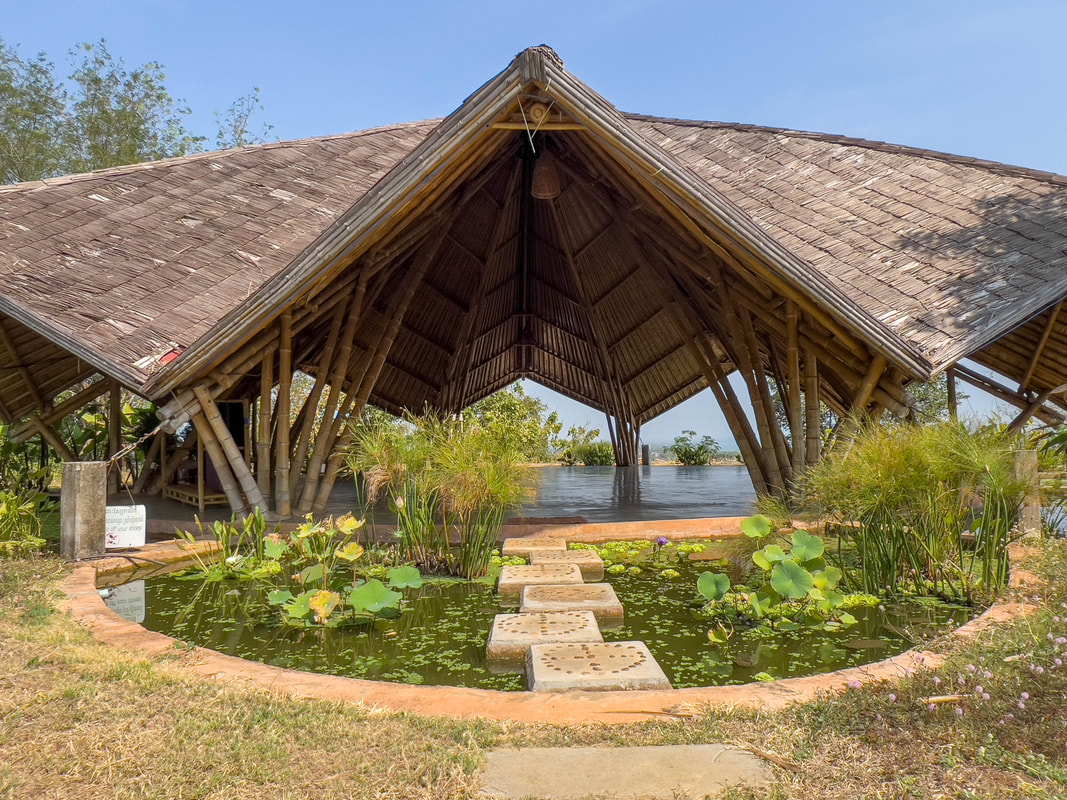
This property’s restaurant and yoga space were perched atop the hill to maximize the breeze and view while each set of guests had their own ‘cabin’. I enjoyed the evening yoga session so much I convinced Rick to join me the next day before breakfast. With the birds and insects in full chorus, the classes (just us attending) were a perfect way to start our day. The location was opened by Buddhist monks for orphans to live a Buddhist lifestyle while also providing lessons in English and how to work in the hospitality industry – a path to earning a living.
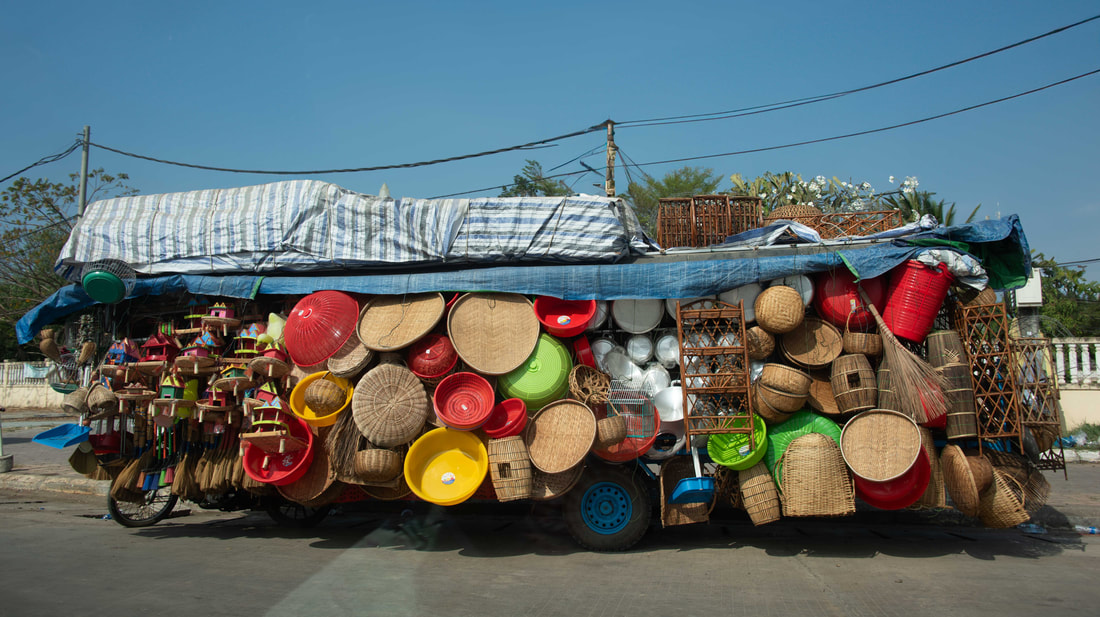
In a population of 16 million, there are 5.7 million motorcycles and only 700,000 personal automobiles which is 4% car owners compared to Canada with 83%. Half way through the trip we were the only foreign tourists we’d seen at any of our guesthouses with our own car. One hotel employee was very surprised that we were driving on our own. Above: So much was asked of motorbikes towing loaded up flatbeds.
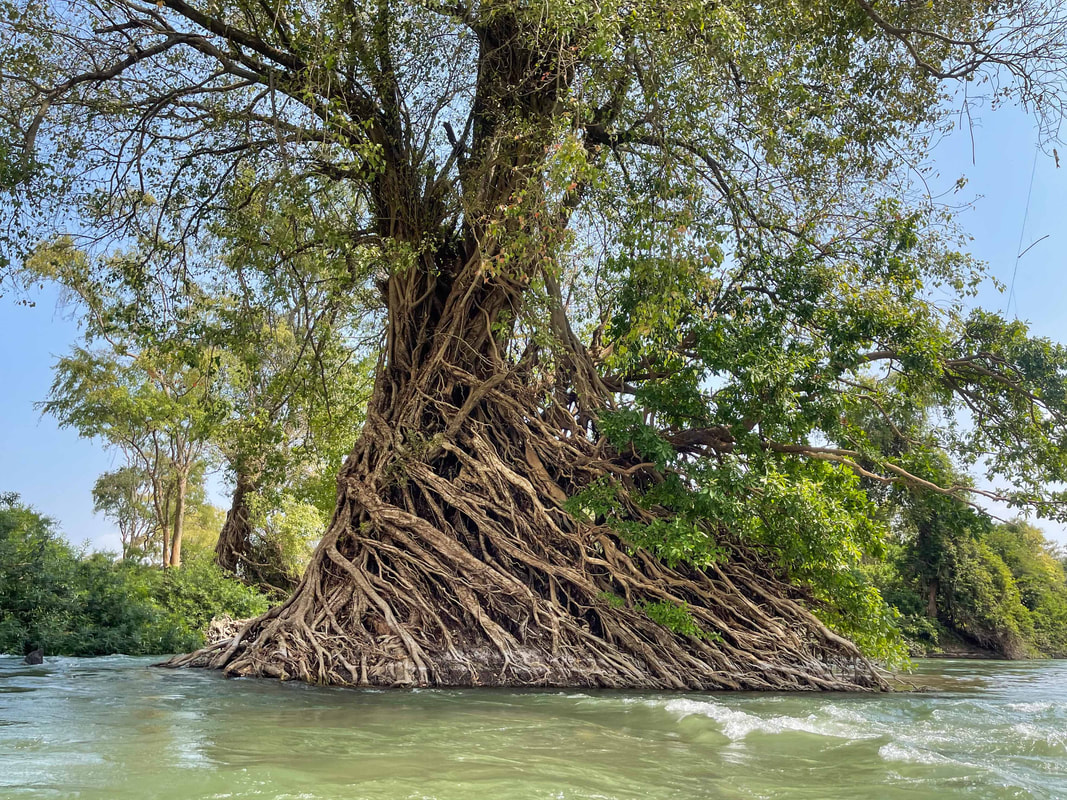
Kayaking the Mekong River to see the last of the 90 or so dolphins, endemic to this area. With conservation efforts, their number is holding steady while those along the Mekong in Vietnam and Laos have become extinct.
Once again, we expected a lazy drift along some Disneyesque river, but we ended up running low grade rapids following our leader’s constant urging to stay in a straight line to dodge the rocks and sweepers. (Kratie, Feb 3-4)
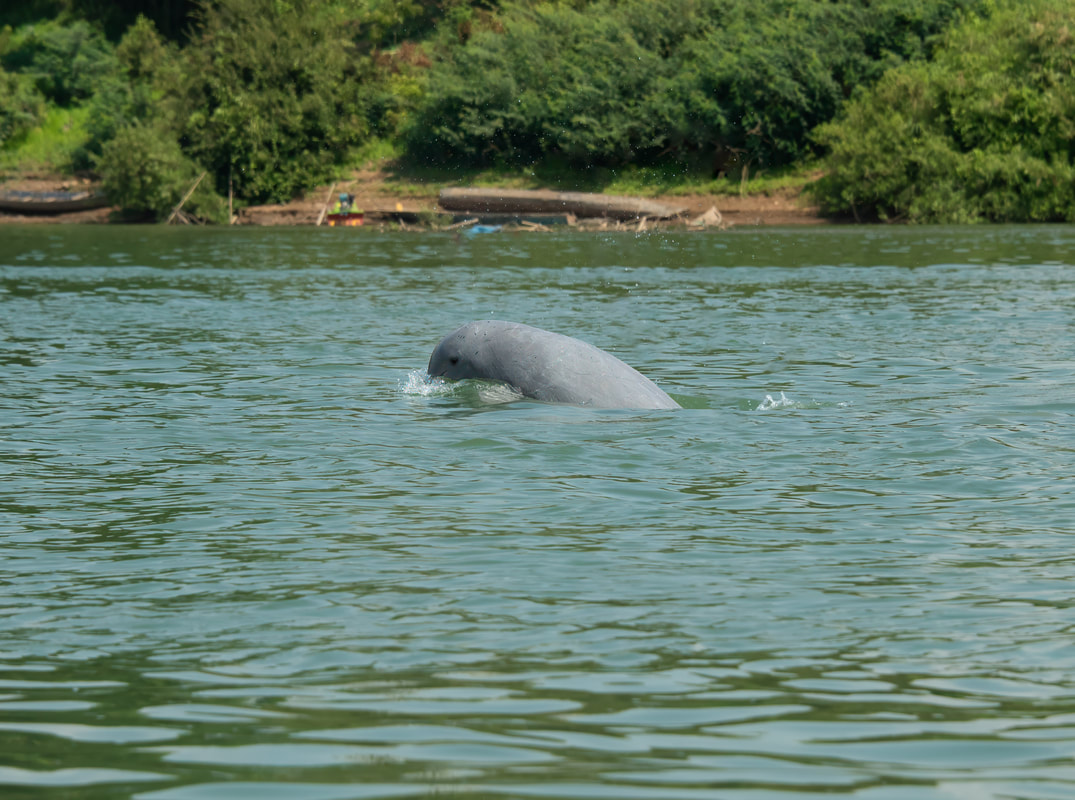
After an 11km paddle we saw a set of 2 dolphins and watched them play around us for a while. In a newspaper a few days later, there was a picture of a new baby dolphin that was added to the group. Of the many continuous shots I took I finally got one where you could see the eye. As usual, Rick and I were easily the oldest participants. When we got back to our start point a lady told us she hopes she can be as active as us when she reaches our age…awww
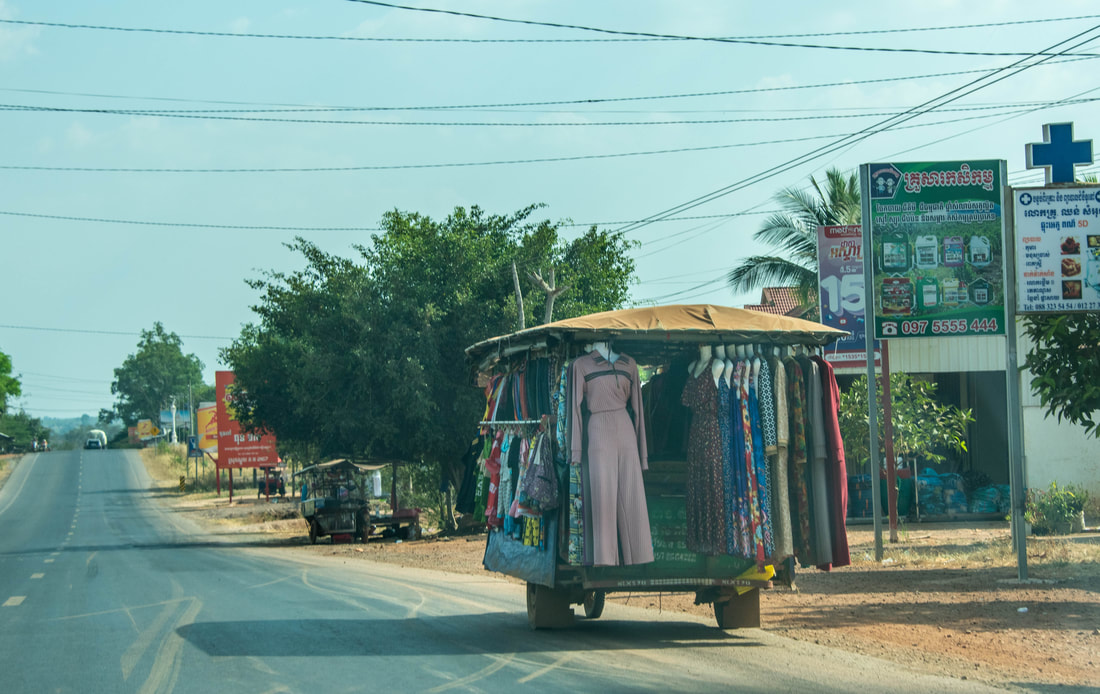
Today’s journey paralleled the border with Vietnam. Only when we headed south and then west did we fully realize how rural and non-touristed the northeast really was. Very few shops were traditional front door style. Instead, ones wares were displayed at the back of the motorcycle. Don't let the huge red and gold signs fool you, the 2 beer companies must have a competition for who has the most signs in Cambodia and the humblest business was reason enough to erect one. So many owners ran a small roadside
stand, it was hard to understand how there were enough shoppers for all the food and goods on offer. (Sen Monourom, Feb 4-6)
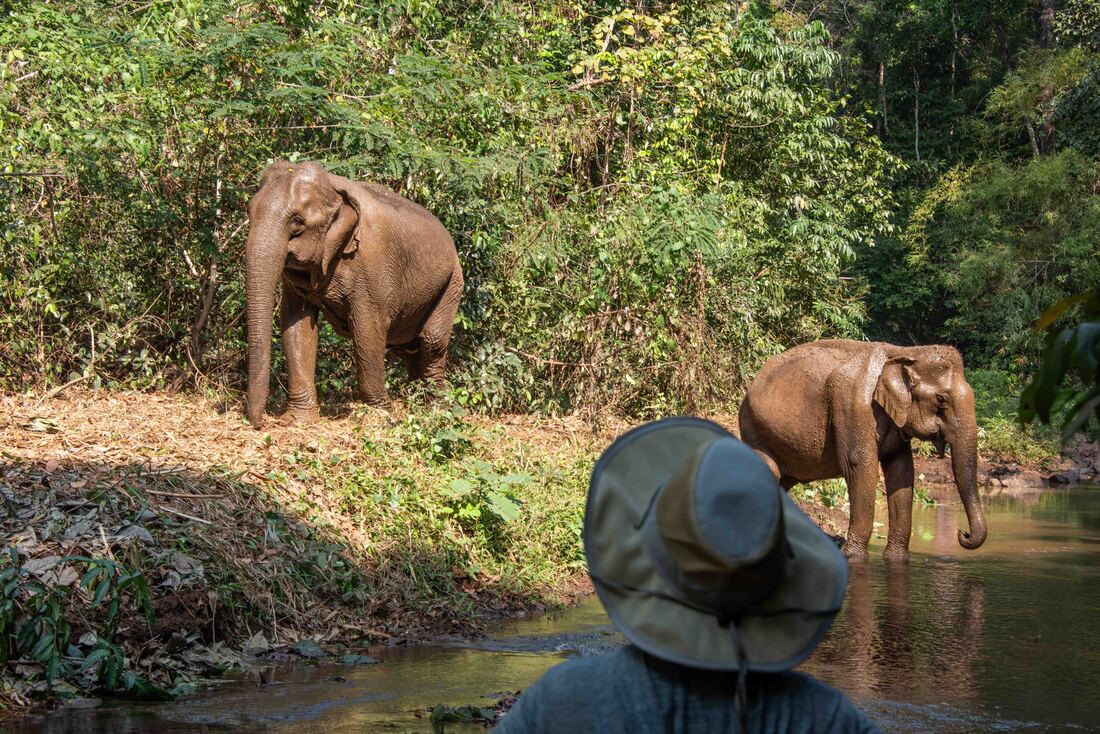
After 2 weeks of stifling heat and humidity we’re in the hills for some respite. Today we spent a full day at an elephant reserve - the only one in Cambodia approved as a true reserve for injured elephants. Associated with the WWF, the elephants roam freely in the largest protected patch of forest in SE Asia (1,500 hectares). No touching or riding, only quiet time to watch them go about their daily business, each under the care of its own mahout. Elephants are considered sacred in Cambodia and this 51 and 61 year old friends were being pampered until their end of days.
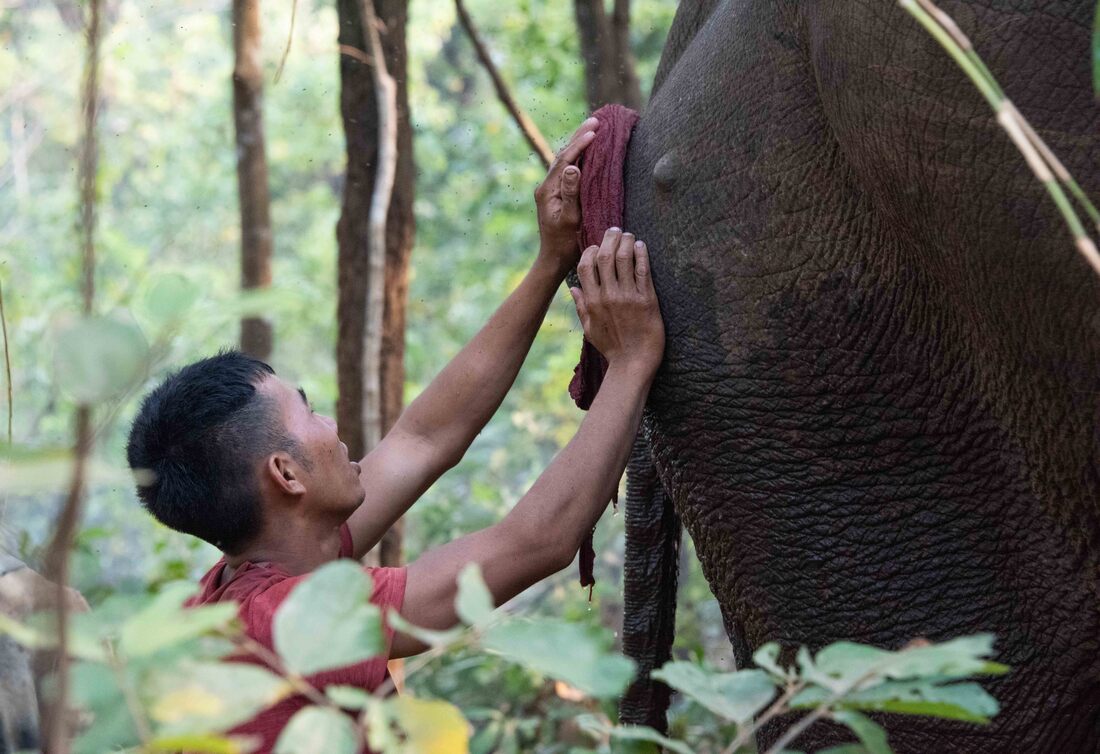
The bull’s mahout was second generation - his father owned the elephant for farm work and then it was donated to the reserve where sadly it was attacked by a wild bull elephant which caused a dislocated hip. The bull only allowed the mahout to ride him which calmed the animal while it was washed. Above, the mahout is applying a medical compress to the hip.
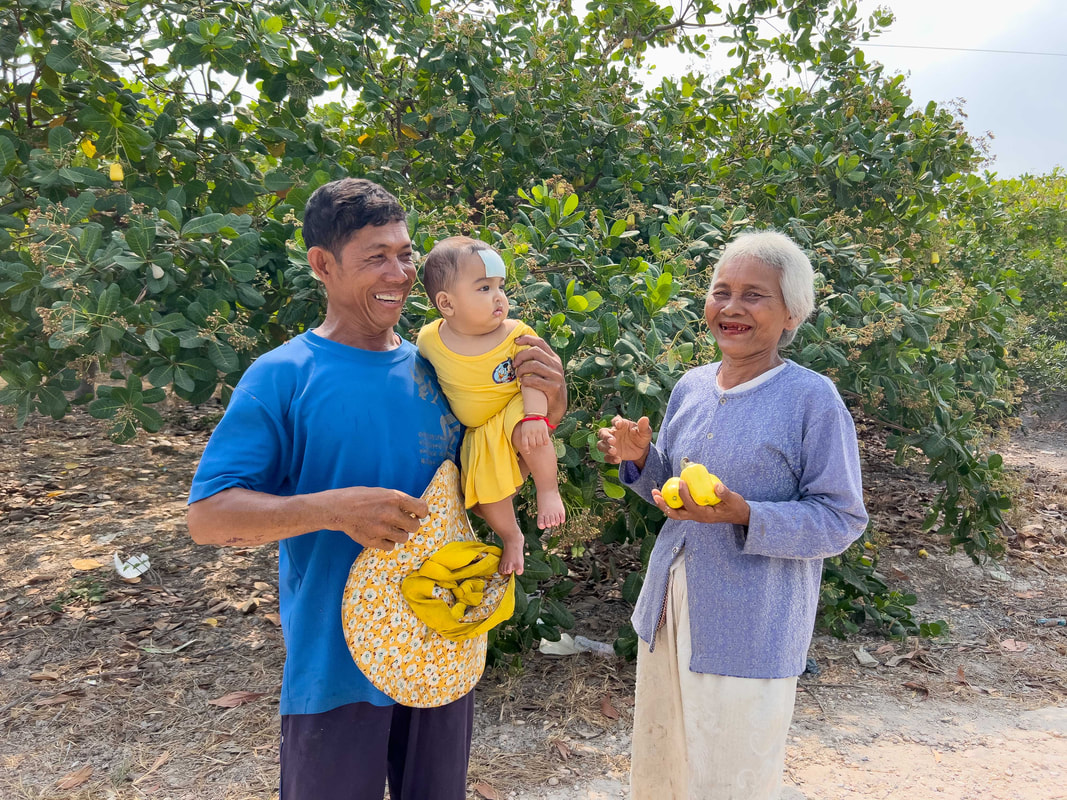
The northern drive passed orchards of cashew trees. The nuts are about twice the size as at home and the country is known for its organic growing practices. The cashew apple that is attached at the top of the drupe (cashew seed) can be processed into a sweet but tart fruit drink, or like so many fruit fermented into a liquor. We stopped to take a picture of the fruit and this couple came out to meet us. They were so friendly and kept wanting to give us more cashew fruit. It got kind of comical – we kept indicating no more as she was filling our hands and the husband was just laughing at his wife.
The day before we were to get transport for a kayak outing was off to a dubious start. But by the next morning the submerged boat was as good as new and we were off for the days adventure. (Stueng Trung, Feb 8-9)
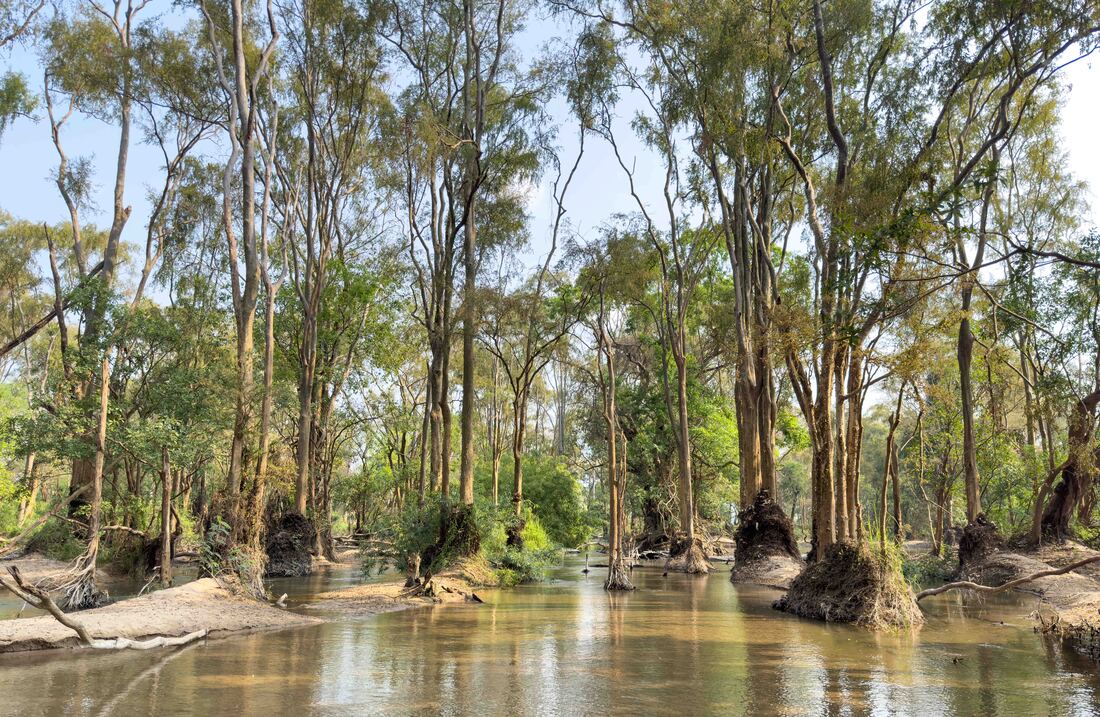
The plan was to kayak through the Flooded Forests, but because the water was shallower than usual, it was a walk through this section where the tree roots have been sculpted by the rainy season’s rush of the Mekong River. Unfortunately, a dam was placed upriver and rather than seasonal flooding the trees are subjected to regular mini floods. This doesn’t give the aerial roots enough time to dry out like they normally would during the dry season, so they’re dying off from root rot.
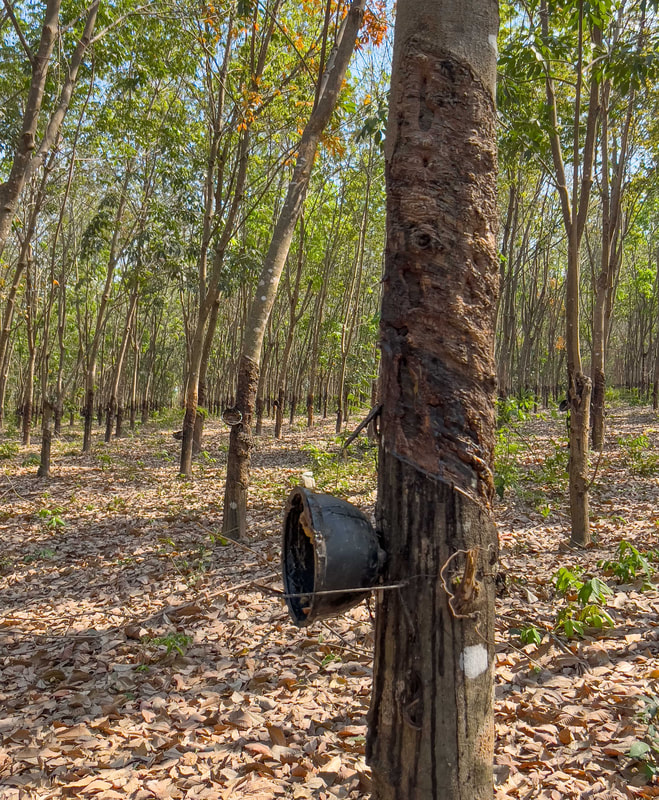
The drive from Stueng Trung to Stueng Saen, took us past orchards of papayas, banana trees, pistachios and the ubiquitous cassava. It was picturesque to see all that green where elsewhere it’s often brown fields since it’s in the middle of the dry season. Further south, a large rubber tree processing plant sat beside a significant tract of land planted with rows of spindly rubber trees. The tree trunks are grazed until the sap (latex) drips into the open coconut shells. To prevent the sap from solidifying, ammonia is added. Acid is then added to the mix to extract the rubber, in a process called coagulation. Most will end up in automobiles as tires and parts.
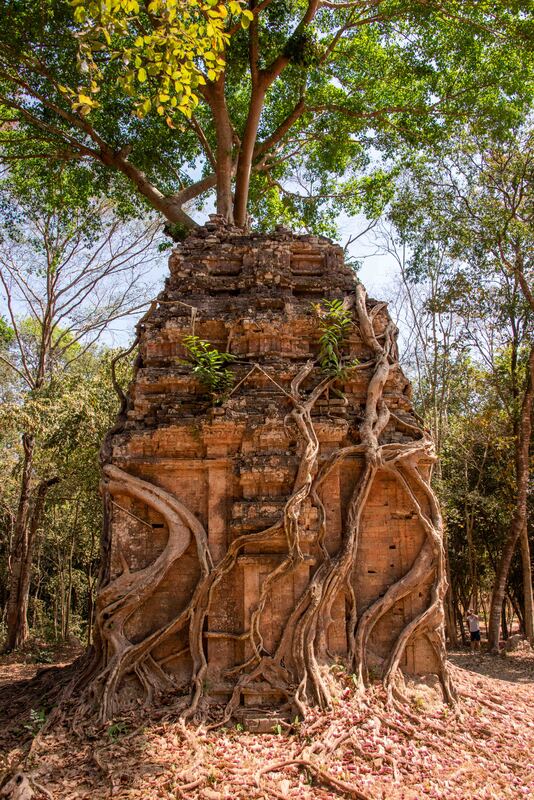
Forest of Many Temples - this 60+ collection of temples was known as the ‘first city’, circa 500-800CE. Later it was usurped by the ‘second city’, Angkor Wat, the current highlight of Cambodia. Abandoned for centuries, the first city’s significance was only recognized recently and is now protected and being restored by locals under the guidance of UNESCO. Above: Temple Trei is the most photogenic with the Strangler Fig growing out from the top and twining its base. (Sambor Prei Kuk, Feb 11-12)
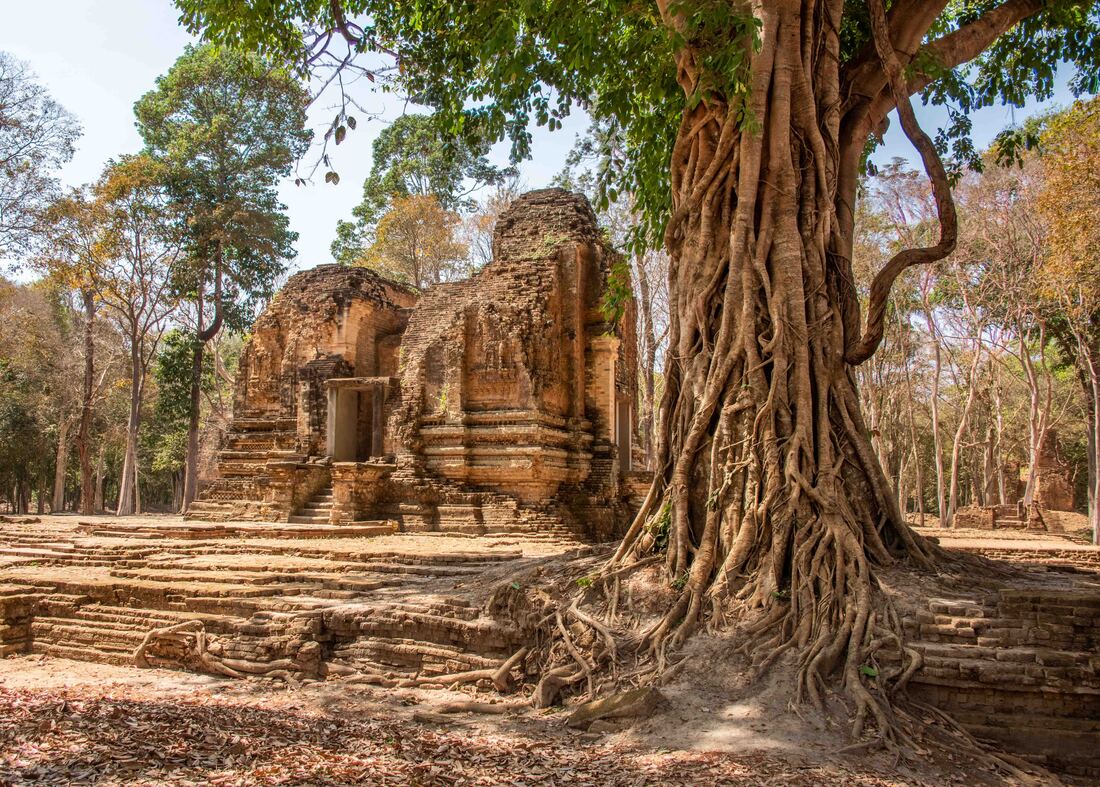
A local woman offered to guide us around and we’re glad she did. It was an opportunity to support a local entrepreneur in this very small town and she answered our general questions about life in Cambodia frankly but always with some context. Hinduism was an early influence in Cambodia, later joined by Buddhism, and the collection of temples honoured both with shrines and reliefs of symbolic gods, humans and animals etched in the limestone and brick. A later visit to the National Museum of Cambodia in Pnomh Penh featured several statues from Sambor Prei Kuk – there they were protected from the elements and any poaching.
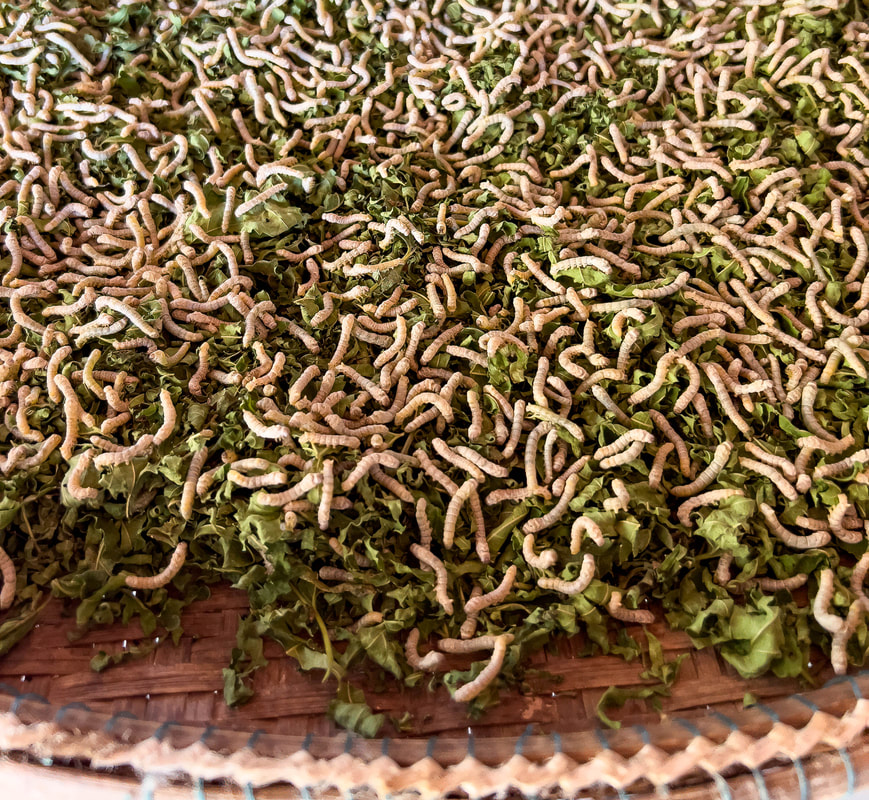
A no-frills visit to an independent silk farm was fascinating. Started 2 decades ago by a Vietnam vet and his Cambodian partner, the goal was to breathe new life into what was once a prolific silk industry while also providing jobs to locals. We learned the lifecycle of silkworms and the end-to-end process of working with their silk. Larva are first kept in a bed of mulberry leaves to feed on (their sole food). When about 1” long the caterpillars are moved to another bed where they’re left to cocoon. Of those, some are removed to develop into butterflies to mate and produce the next batch of eggs.
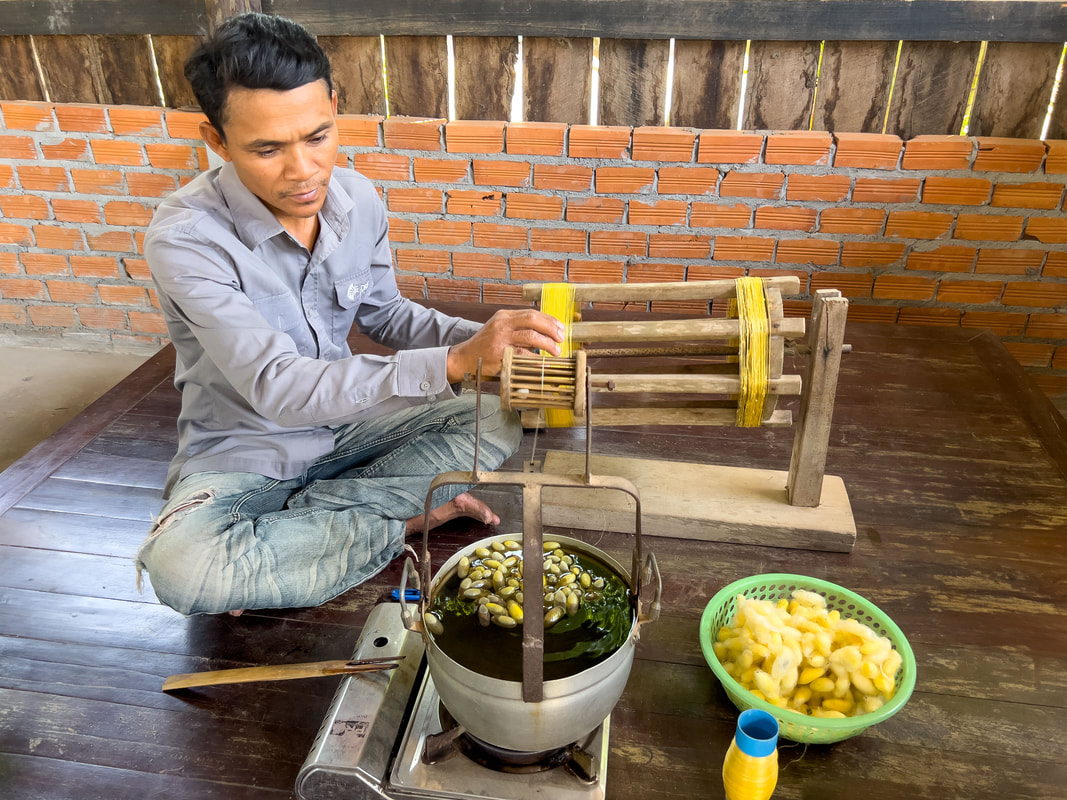
To process the silk, first the fuzzy outer layer is removed from the shell and spun to be used for raw silk fabric (right side of wheel). Then the de-fuzzed shells are slowly added to a pot of heated water until there are 60 in the pot. When the pods are stirred their silk creates a sticky mass of fibres. These are drawn up with a stick (like cotton candy) to form 60 individual threads that merge into one. This single thread is guided back and forth onto a large wheel for use in weaving. Once all the silk has been removed from the pods the cooked caterpillars can be eaten - we declined the offer. From there the silk is further spun, dyed and eventually woven on the looms. And so started my purchases of silk scarves - 2 there and another 3, days later...
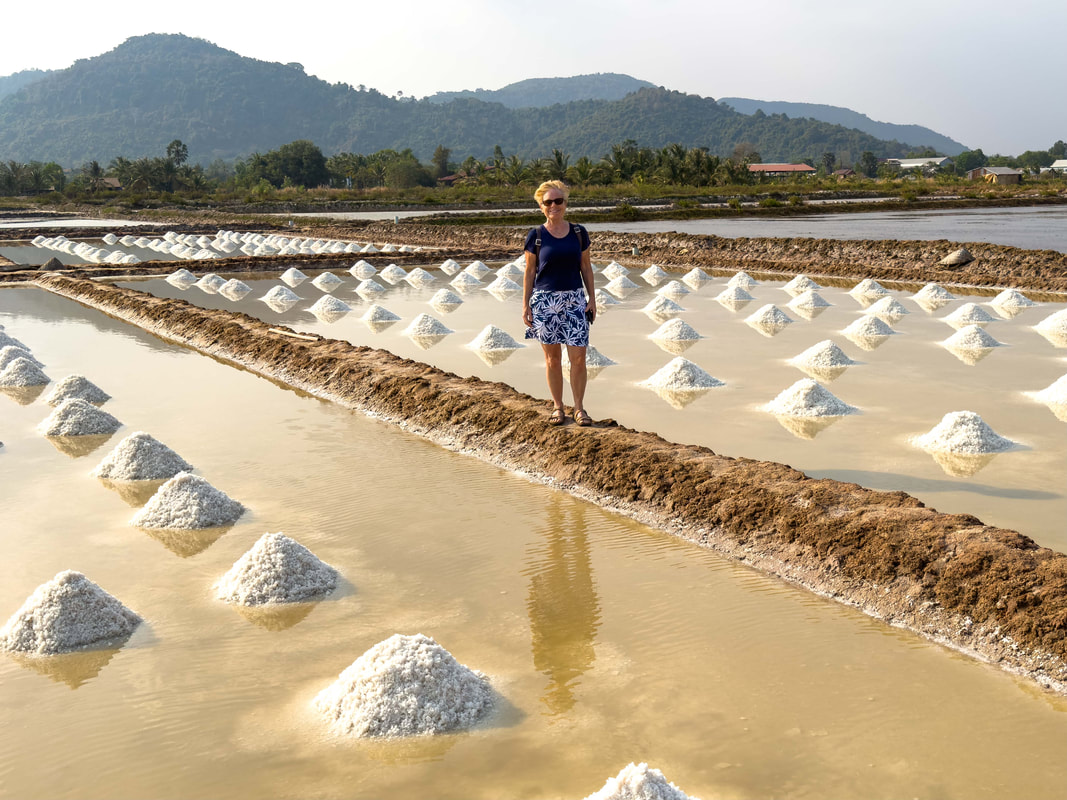
Kampot is rich with a cook's primary spices, salt and pepper, and their quality is exceptional enough to be exported around the world. The production process at the Kampot Salt Fields uses traditional methods which have been practiced by locals for centuries. The operations manager ended up being on site at the same time as us and since we were the only visitors, he was happy to answer all our questions. Every 4 days the following cycle is repeated: nearby sea water is pumped onto the property and dispersed amongst about 300 ponds. Each day the salt is raked into piles in one quarter of all the ponds. (Kampot Feb 13-16)
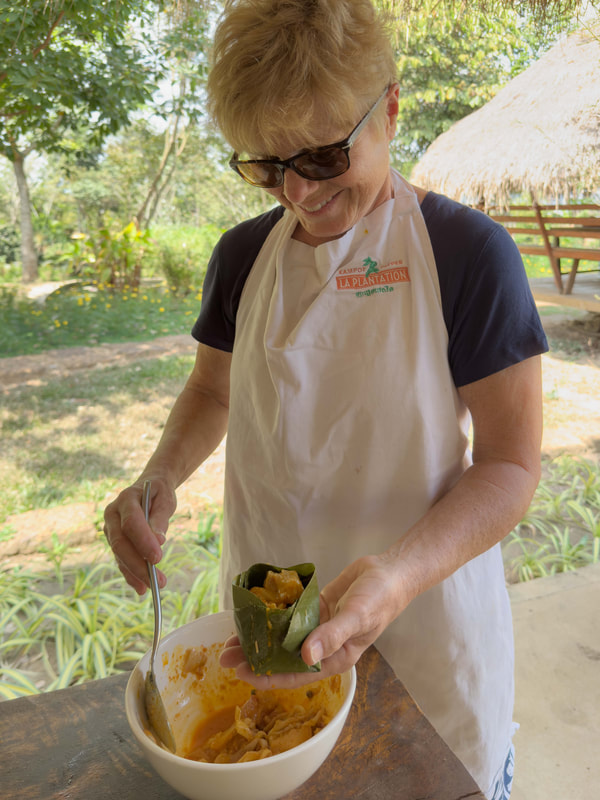
A cooking class at La Plantation Pepper Farm was an opportunity for us to cook traditional food without adding the ubiquitous onion and garlic to my dishes. On the menu was fish amok (above steamed in banana leaves), curried vegetables, green mango salad and vanilla ice cream with pepper for dessert.
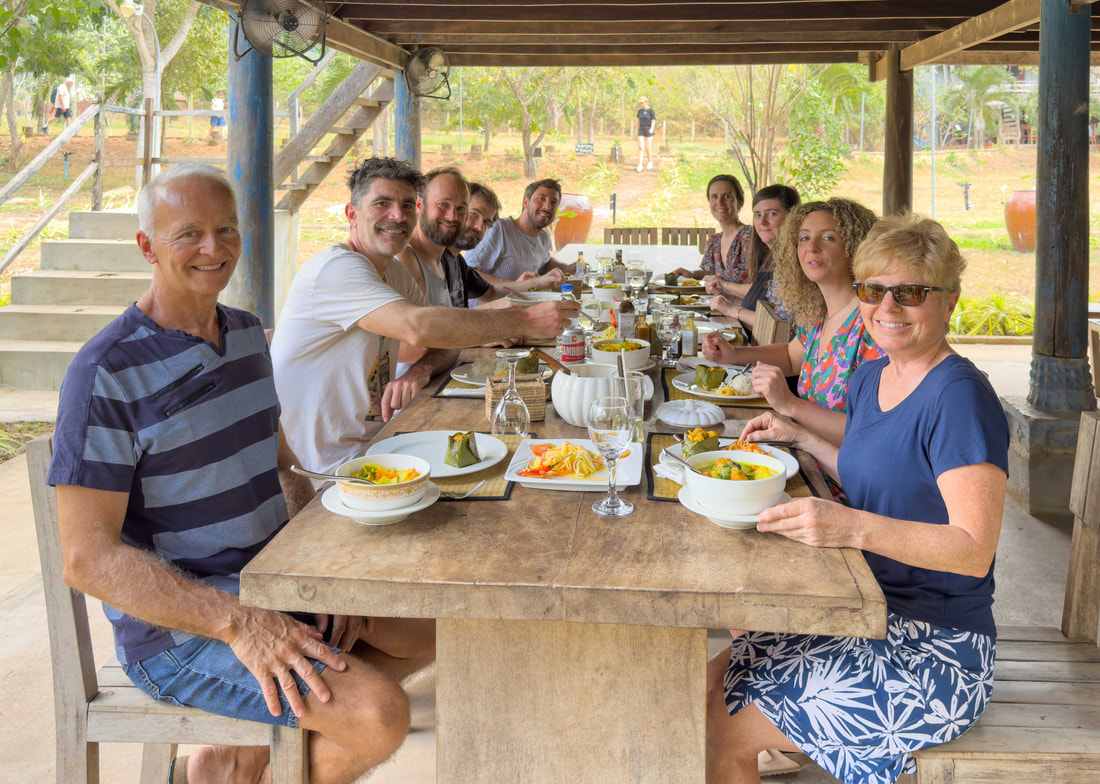
After eating a huge lunch, it was off for a tour of the pepper farm and then a pepper tasting. There were at least 20 different options starting with the basics of green, red and black peppercorns through to infusions like citrus and paprika. Interestingly the women have been found to be better pepper pickers, patient and particular (say that fast :) – while the men have been relegated to the brawn jobs.
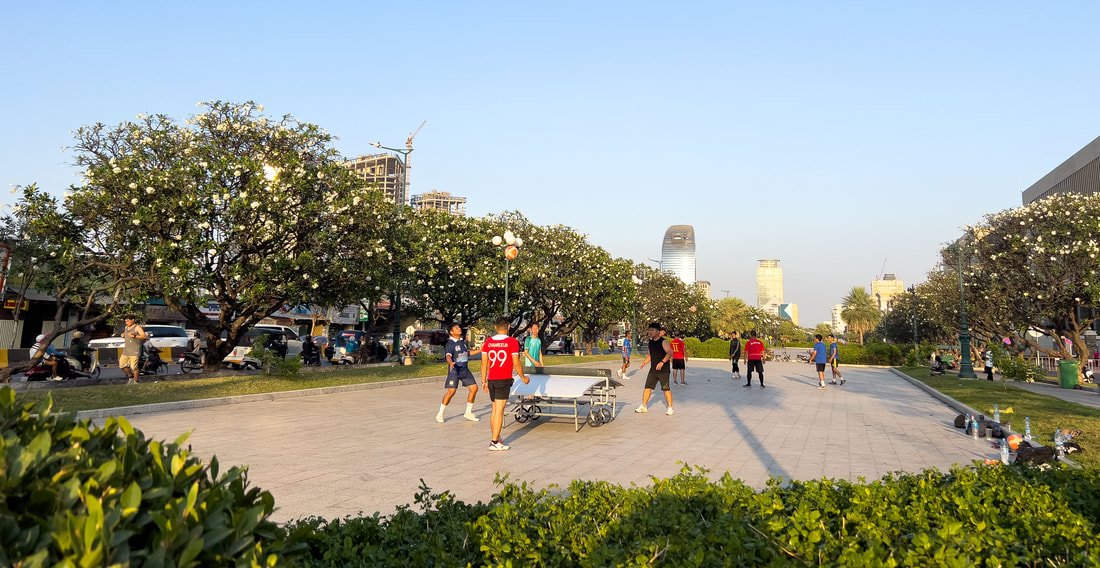
We enjoyed the capitol city with its riverside path, leafy neighborhoods, museums, temples, and Royal Palace. Like other larger towns, there were several blocks-long wide boulevards (above) lined with long established flowering trees. The areas were used for all sorts of activities, including evening fitness classes where quick beat, thumping music set the pace for gyrating exercisers. It was exhausting watching them when the temperatures had only decreased to about 30C. (Phnom Penh, Feb 16-20)
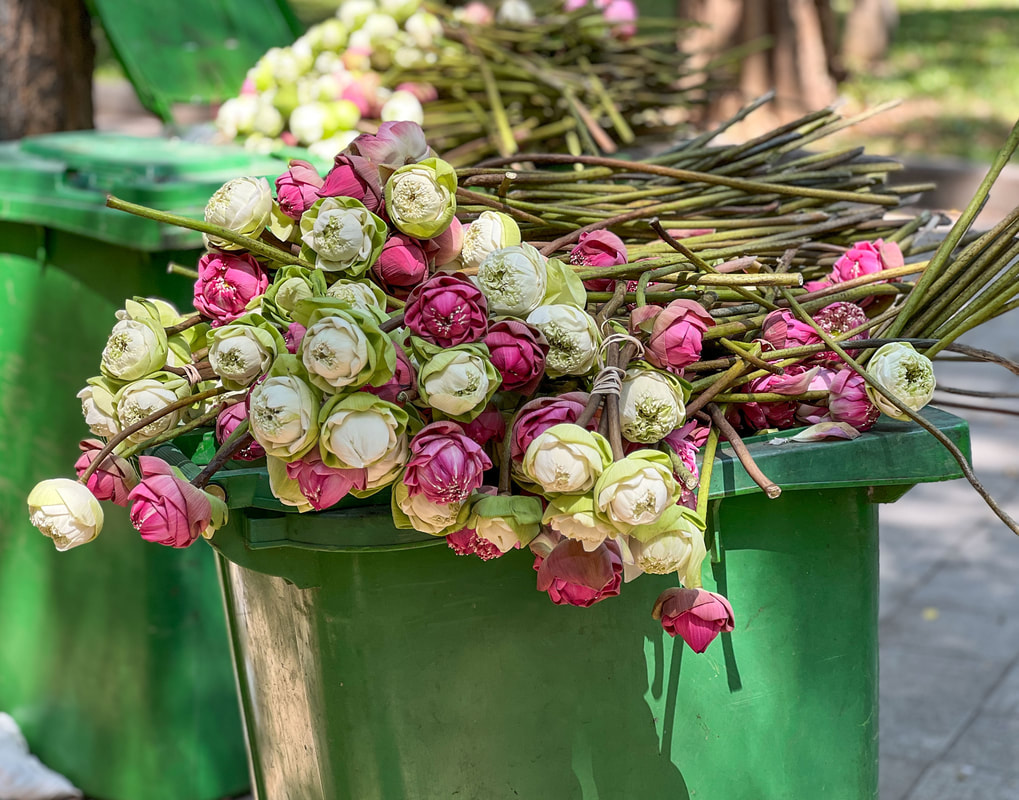
The volume of gifts was such that helpers inside the shrine would constantly collect the offerings and most were tossed out a window and into garbage bins just outside. The best produce appeared to be set aside for eating. Driving up country, there were a few large fields of lotus flowers being cultivated for their important but short life.
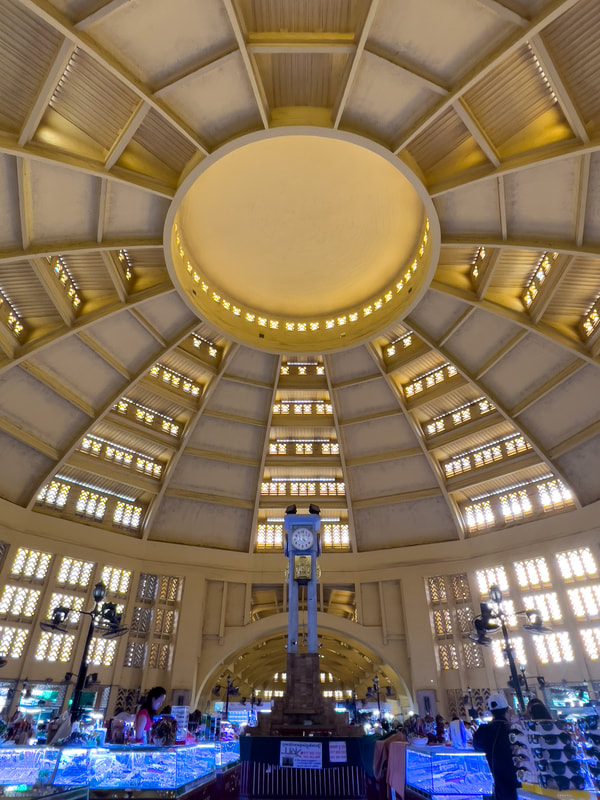
An iconic market in Phnom Penh was the art deco Psar Thmei. Unlike sweltering and densely packed local markets, this place was built with a high ceiling and 4 wings and its design allowed for maximum air flow making it an enjoyable place to shop. We enjoyed going up and down the aisles and even managed to buy a couple of items we'd been looking for since we got to the country.
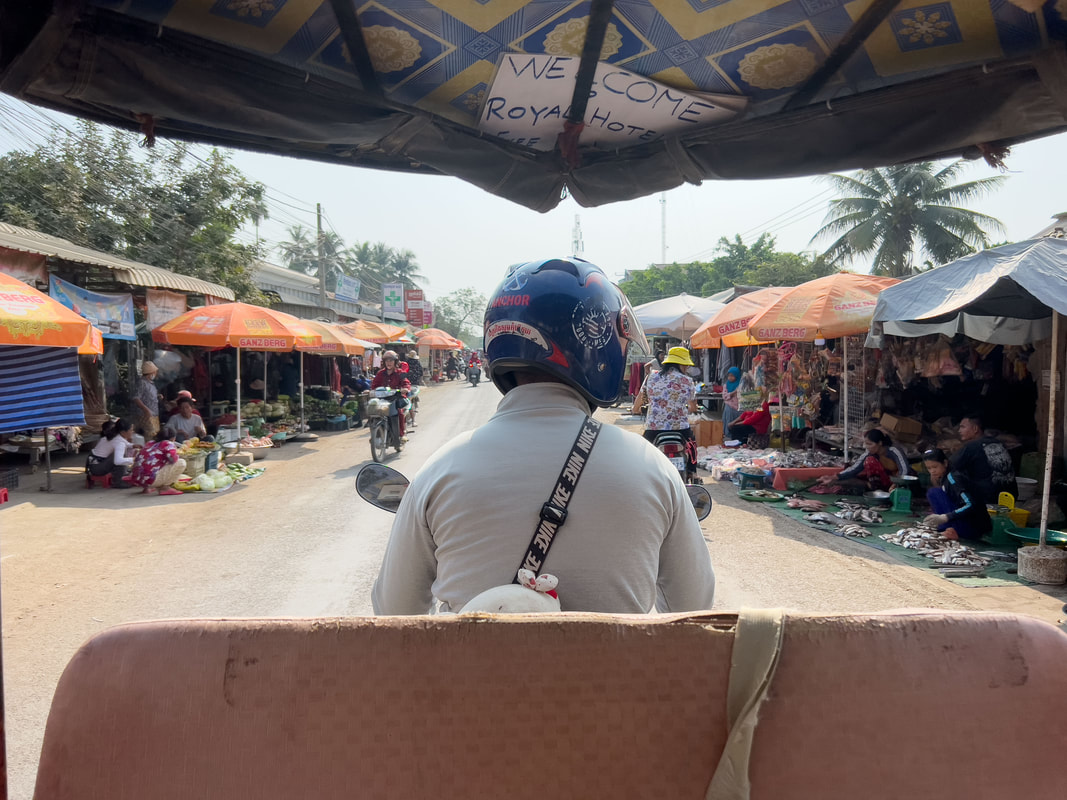
Battambang is the country’s second largest city, and it offered experience tours at a grassroots level. A whirlwind tuk tuk ‘artisan tour’ took us to several home businesses where we were free to wander and take pictures. For the most part we were the only visitors and except for a stop at a food place, there wasn’t anything slick about the visits or any pressure to buy anything. (Battambang, Feb 20-23)
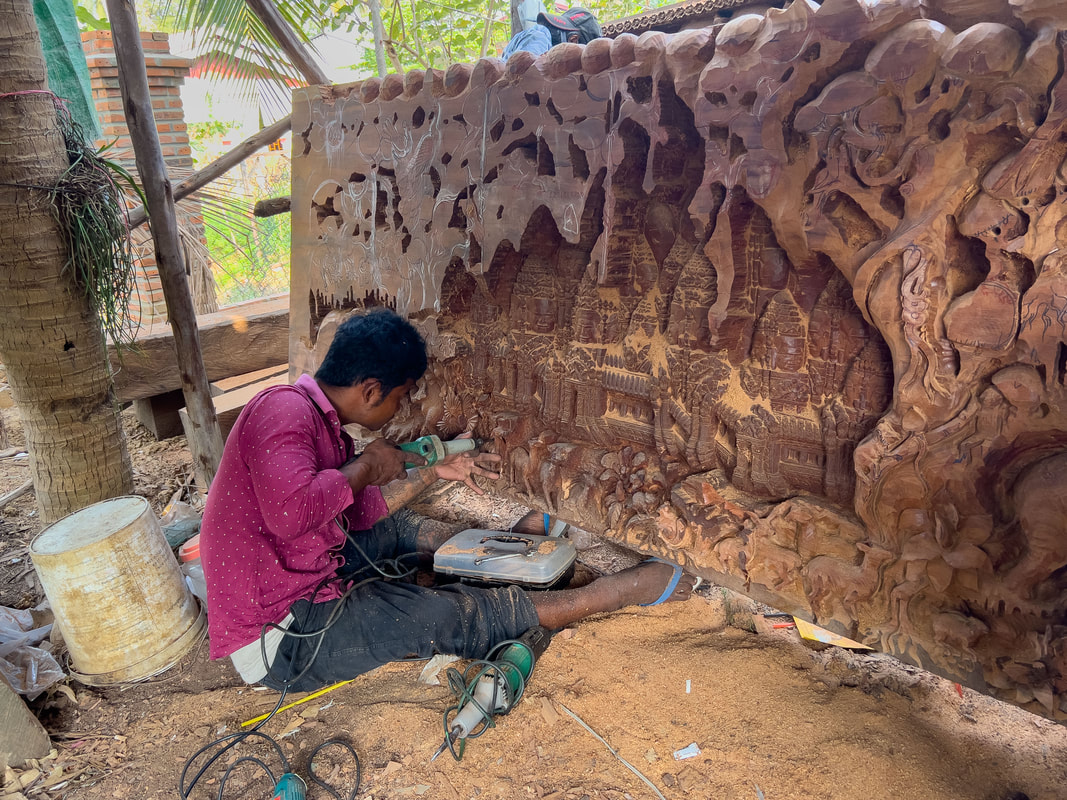
First up was wood carving. In a local’s front yard, young people worked in an apprenticeship program. The master carver first draws a pattern on the wood. From there it can months to years of first broad carving strokes followed by precision tap, taps and finally a good cleaning and varnish application.
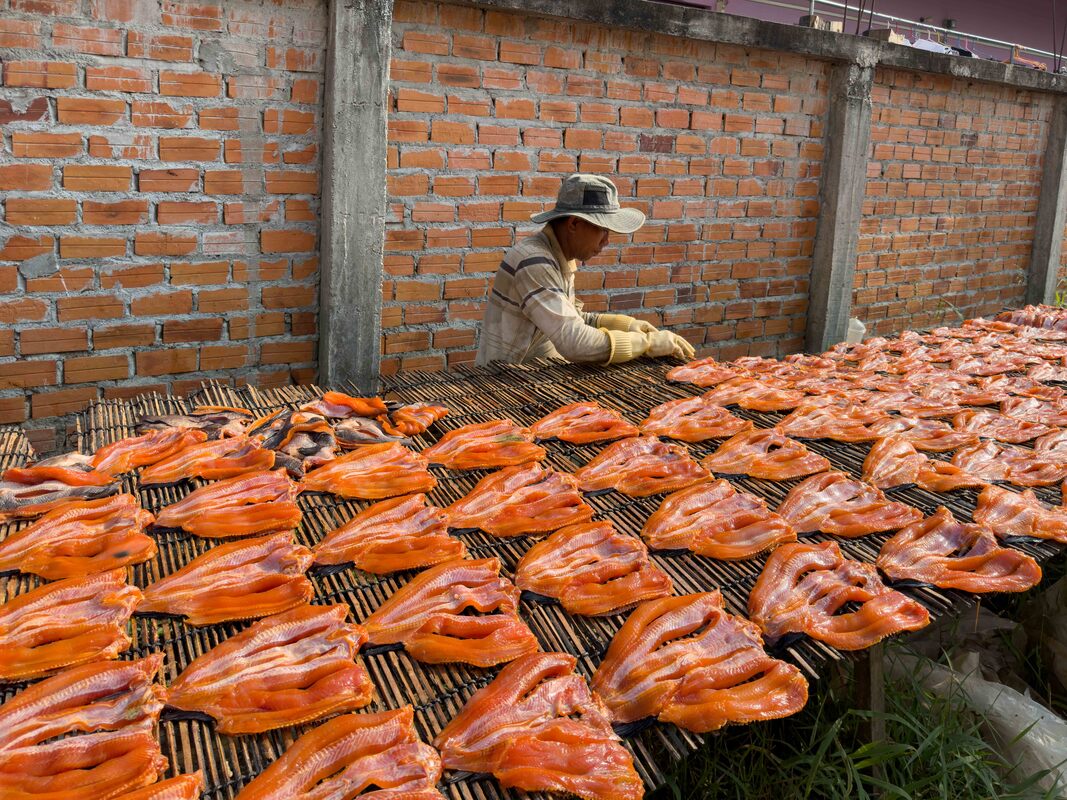
Fish drying took place on well used racks of woven bamboo. The fresh fish was cleaned and then placed in salt water for 2 hours before being spread out on the racks. Depending on the amount of sunshine, the fish dried for 2-4 days, while being regularly turned. Once dry, it was a favourite at markets for it’s intense flavour in salad and rice and that it can keep up to 1 year without refrigeration.
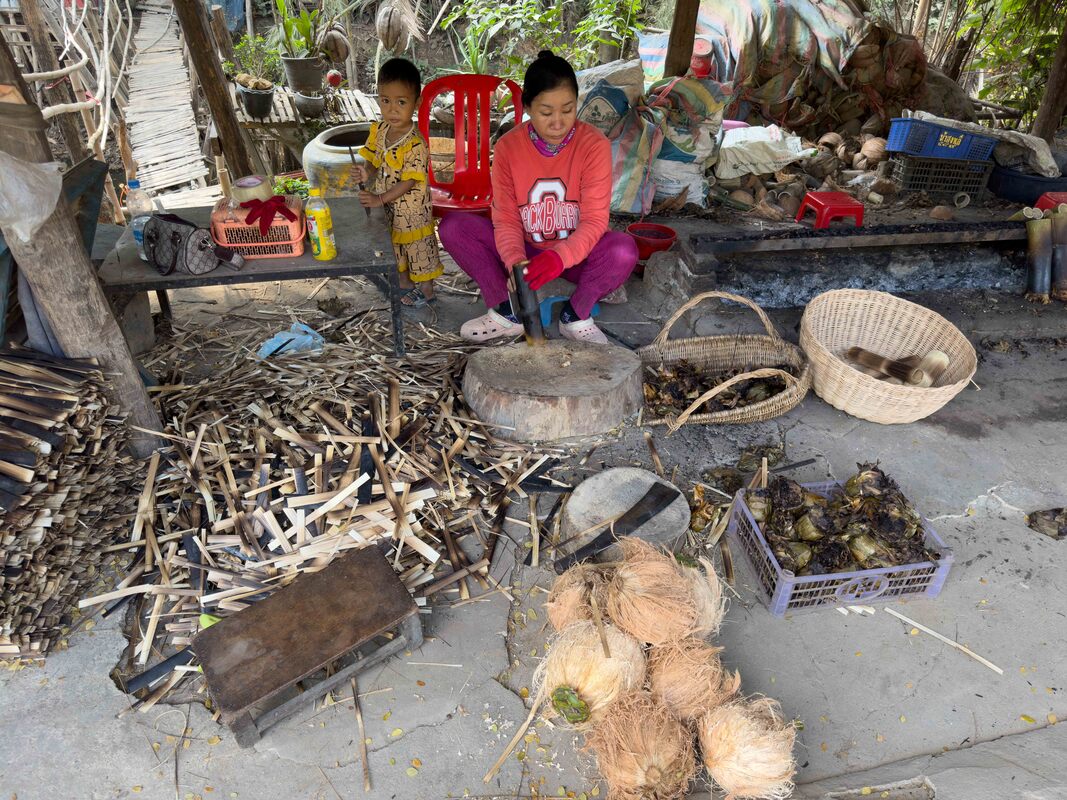
This roadside operation was a study in how to utilize every part of the plants needed to make bai crolan. What didn’t go into the dish was used to fuel the fire for baking. Young bamboo is sliced into cylinders which are filled with a rice paper wrapped concoction of sticky rice, coconut milk, sugar and black-eyed beans. Once the tube is plugged with banana leaf its slow baked over the long low oven to the right. Finally the burnt outer layer is removed (pic) and then sold in front of the cooking area. This family also ships their crolan to wholesalers. Sticky rice isn’t grown as much in recent times, which makes this dish more of a treat.
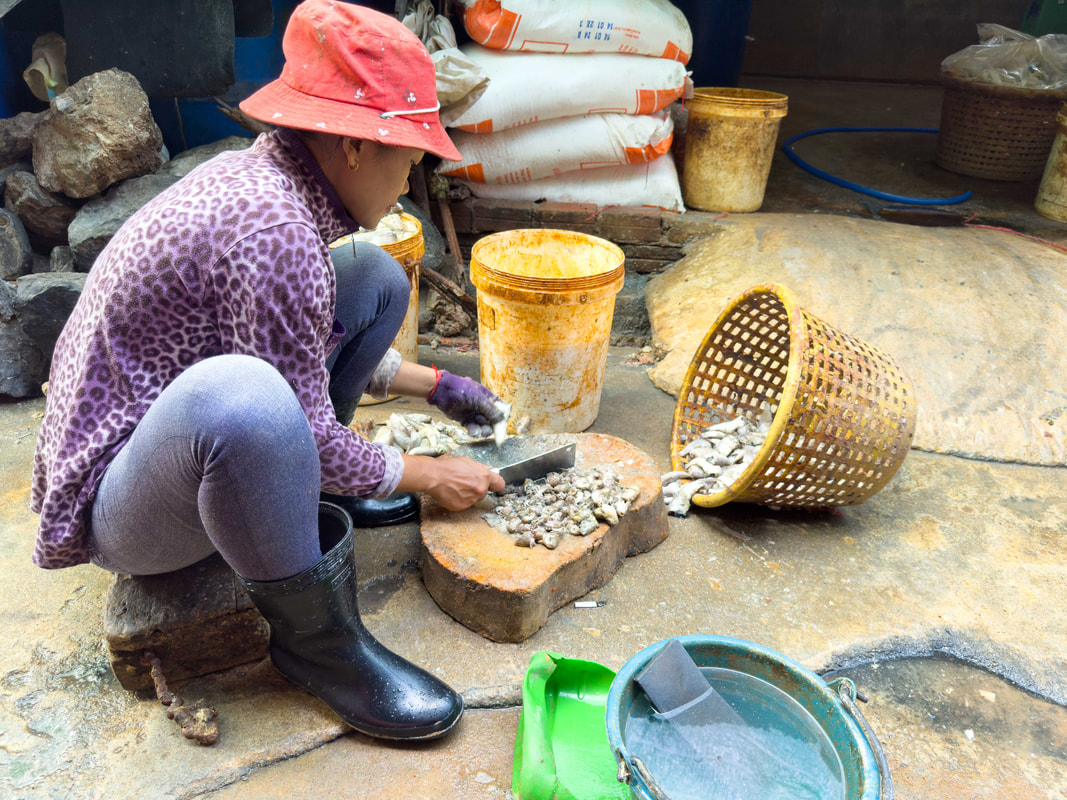
The huge fish processing plant was an olfactory challenge to tour, in part because one of its main purposes was to make the very popular but horrible smelling fish paste which requires leaving chopped up mud carp (above) to ferment unrefrigerated for 3-12 months or longer in tightly sealed containers.
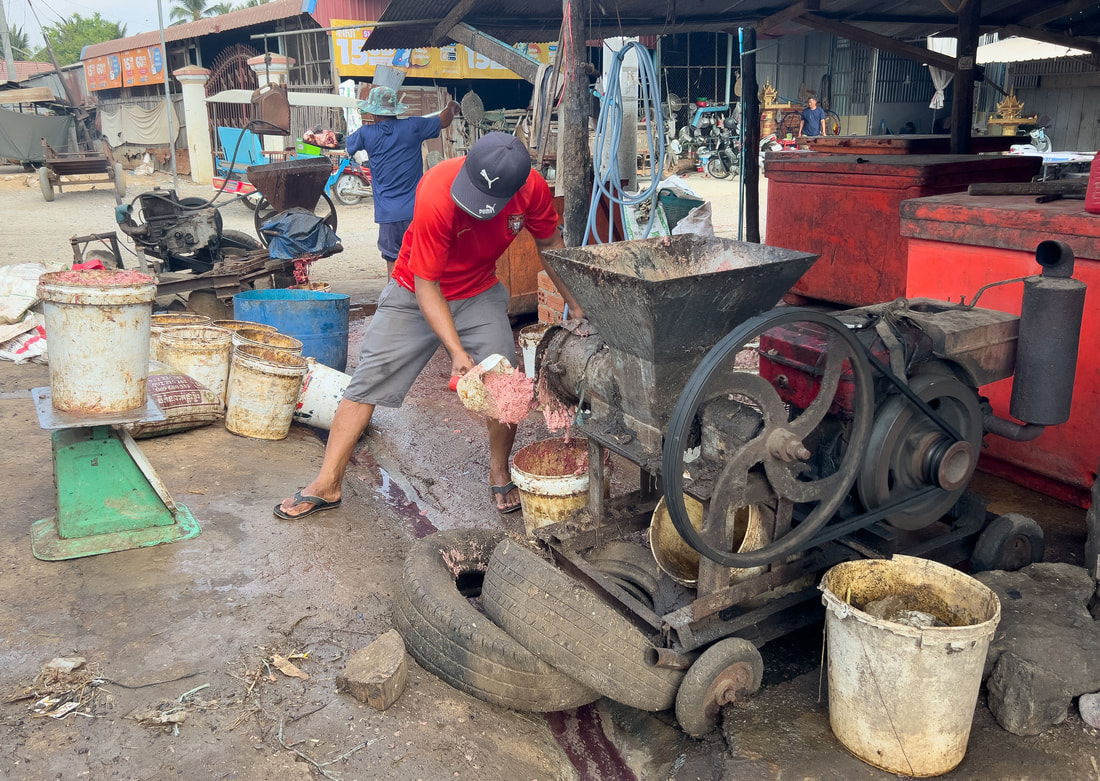
As with food everywhere, nothing was wasted. Once every edible part was used, the remainder was ground up for crocodile food. Sidenote – the Siamese crocodiles are raised for their skins and skulls, but when their numbers approached extinction conservationists partnered with the croc farmers. Today the farmers now supply some of the crocodiles they’ve bred in captivity to conservationists to return to them to the wild.
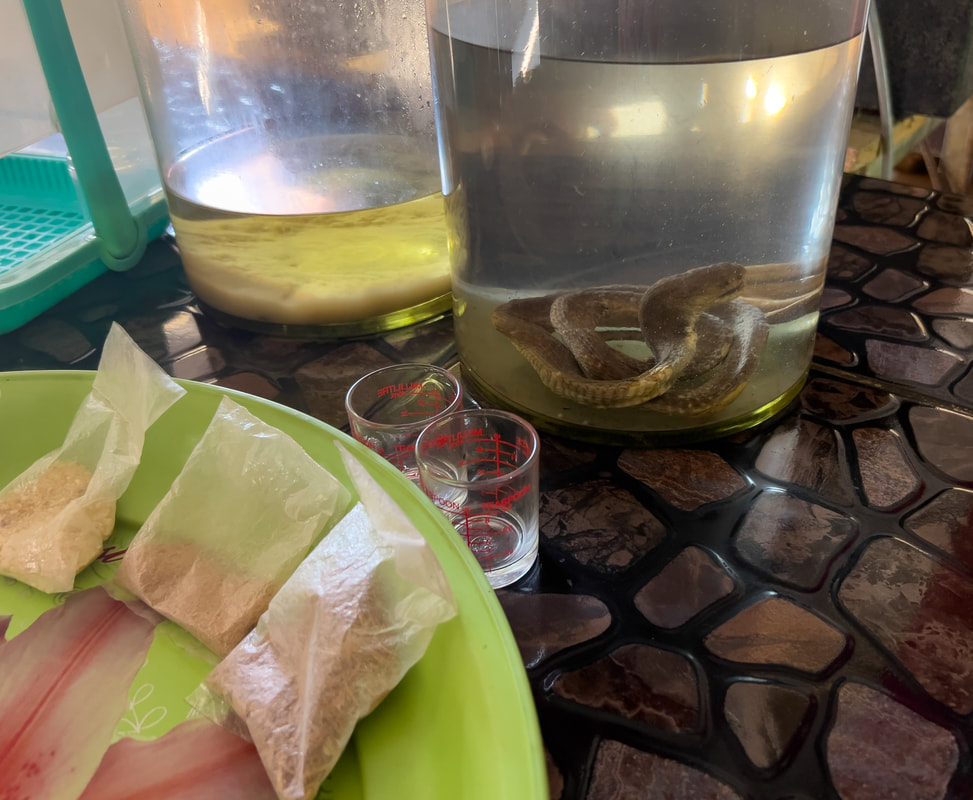
The cobra brew was for the men after long days in the field. The other was for women who had given birth. We were told that for about 4 months after a baby is born the mother must keep up their strength (& patience??) with the help of a generous shot of rice wine every morning, afternoon, and evening.
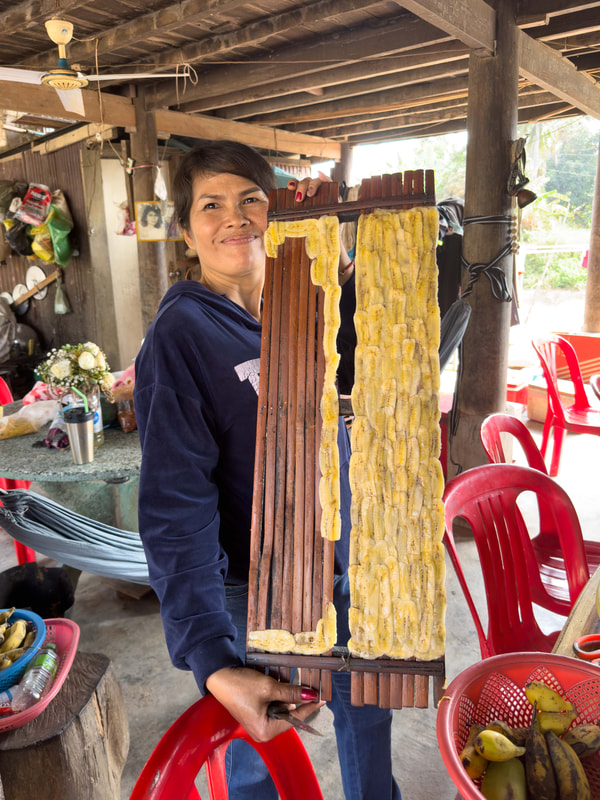
The best visit of the day was with this smiley woman. She was so proud of her business and being able to speak enough in several languages to share what she does. Bananas and plantains are delivered to her from nearby farms, and she parlayed those into sundried chips and fruit leather. The latter makes not only a nutritious snack but wrapped into a cone shape its perfect for holding ice cream.
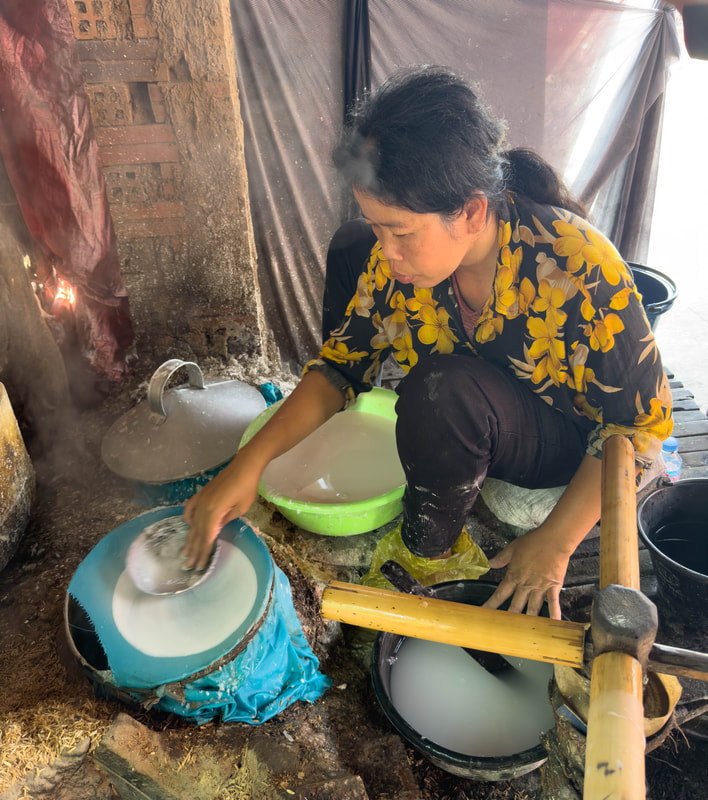
By contrast, the 2 ladies making rice paper for spring rolls had a hot and uncomfortable job. Sitting next to steaming cooktops, one woman poured a small ladle of rice water and spread it crepe-like to create rice paper. Like the rice wine making, it was rice husks that provided the fuel for the fire.
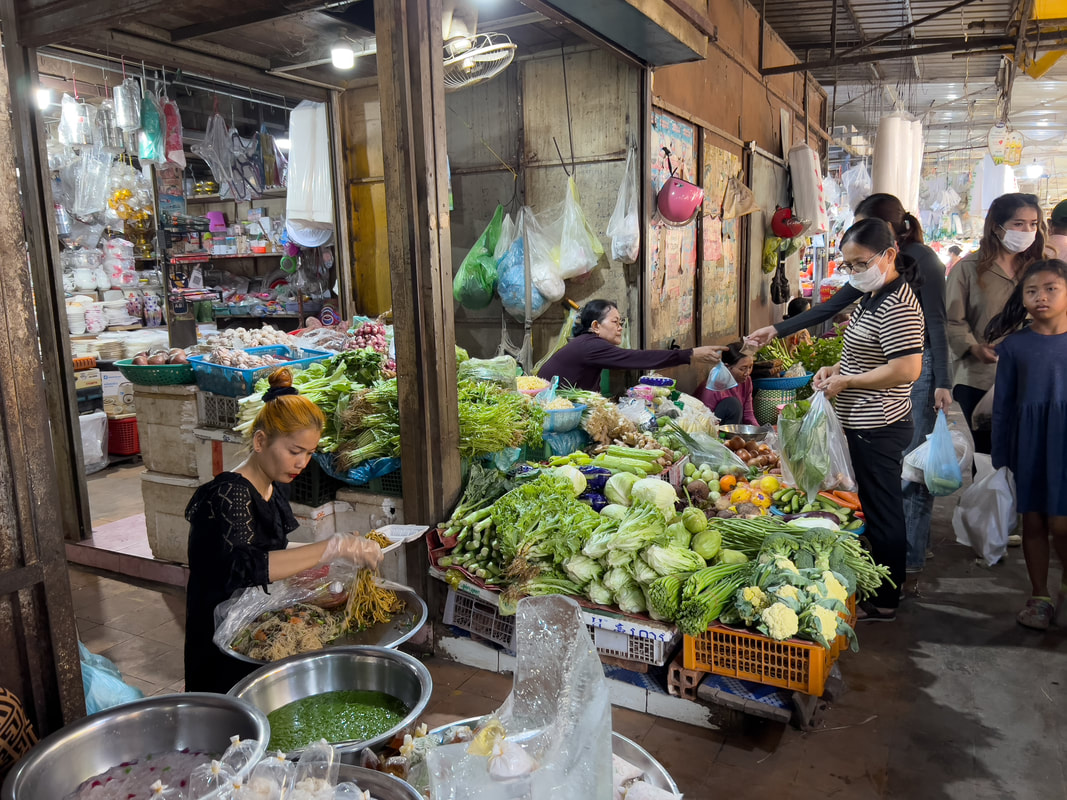
A small family run business operated today's cooking class in their restaurant before it opened for the day's customers. Lyly explained the various ingredients at the market and we could taste a few, but he wouldn't buy all of our supplies as the cost would be inflated to the tourist price while we were there. But we were able to watch our fresh coconut milk being extracted from a young coconut. A byproduct is desiccated coconut that has had its juice extracted. This used to be fed to chickens, but when it was realized that foreign markets would pay to use coconut for baking, it's now sold overseas.
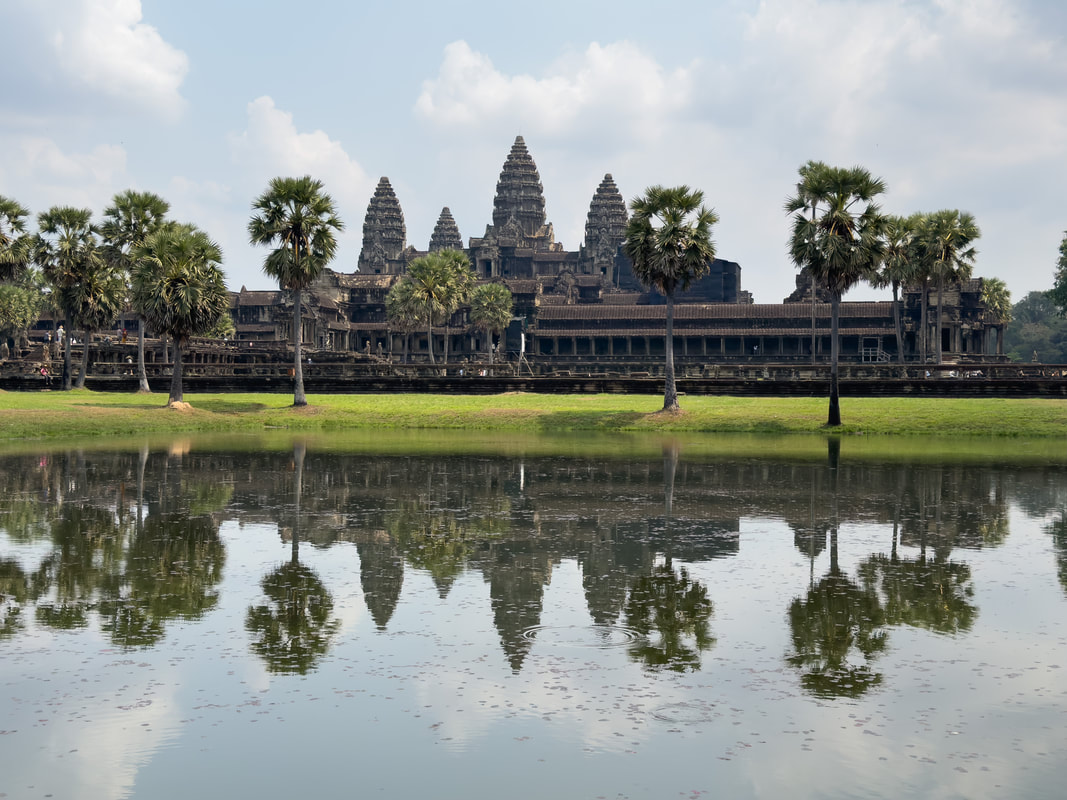
Angkor Wat is the premier temple in all of Cambodia. Built in the 12th century, it and the surrounding Temples of Angkor shifted the epicenter of the country from its previous location in the east. And almost 10 centuries later, it remains the most vibrant and developed part of the country (aside from the capital). (Siem Reap, Feb 23-28)
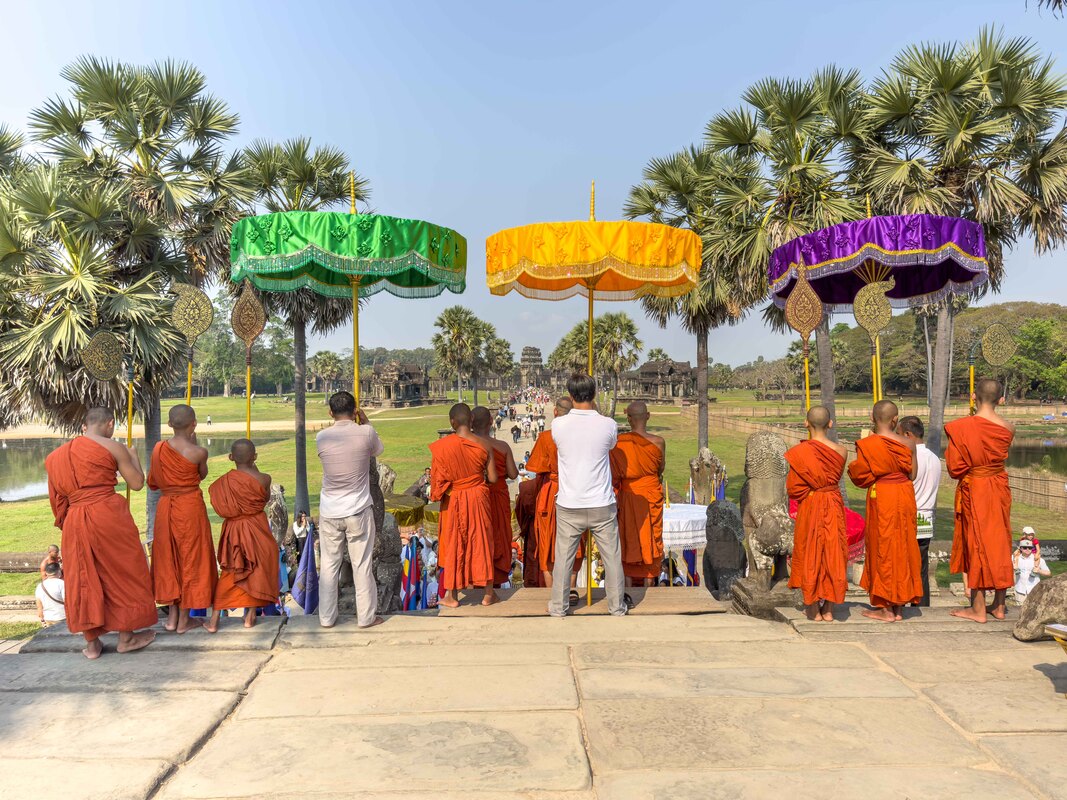
Buddhist monks chanted while one talked to the faithful with his mic in hand and a sound system to rival a band, so that the message could be heard by the long line of faithful praying in front of the monks. Each morning and especially near wats, monks do their alms rounds, collecting food, money, useful items, etc from believers.
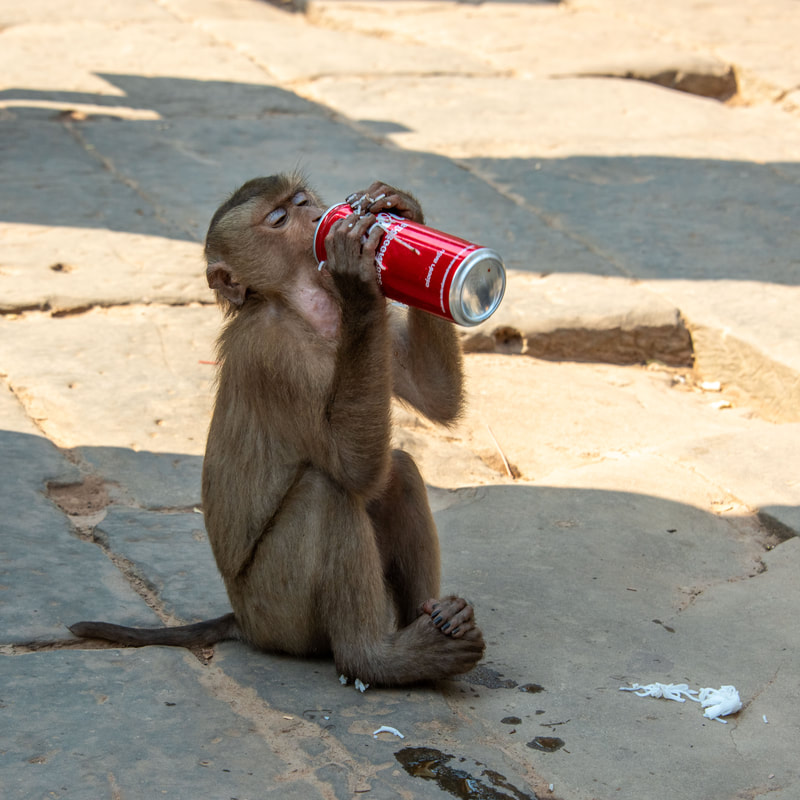
The monkeys couldn't resist wreaking havoc at the small shrine nearby where food and drink had been laid out as offerings. Once the coke had been drunk and food strewn everywhere, they moved to the next shrine on their rounds and the cleanup crew swooped in to clean up the mess. One has to think this is a daily routine.

A school in a nearby city provides a free education for those who are interested in music, art, artisan and circus work and in turn its funded by the partial proceeds from graduates work. It was a fun night watching young children sing and dance and then the circus that followed. The biggest wow for us was this man who balanced on a tower of ridiculously wobbly rollers, each moving in a different direction.
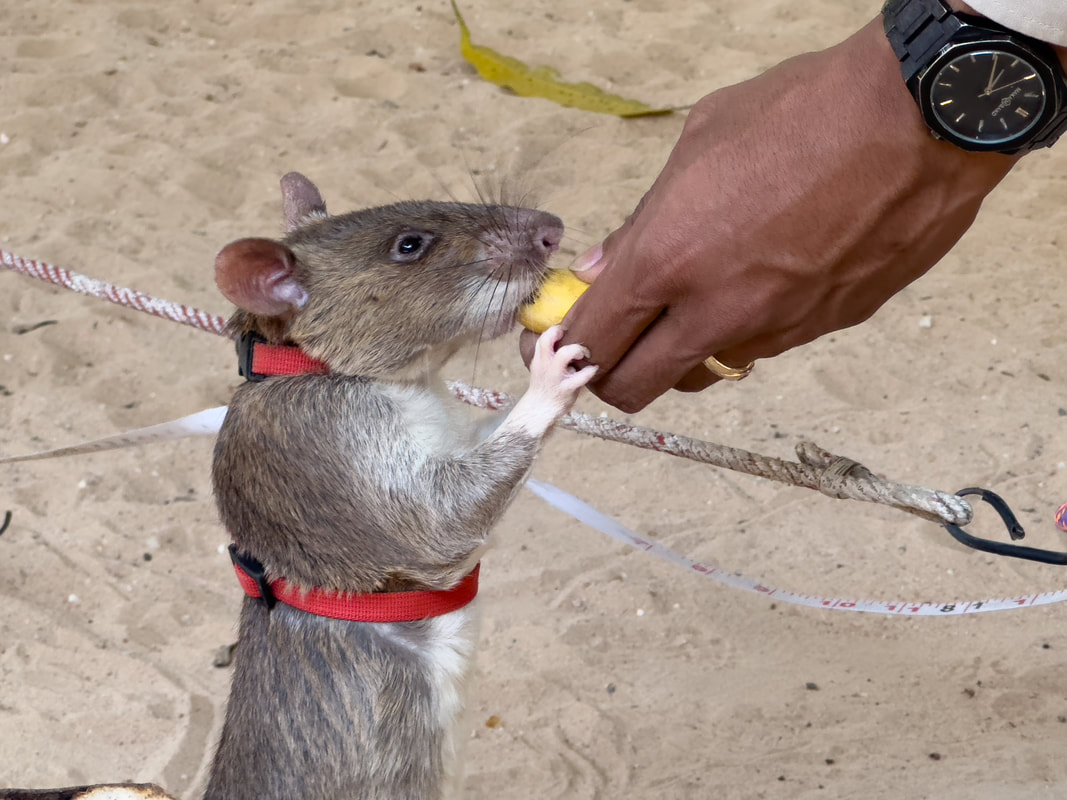
African giant pouched rats have been trained to sniff out the TNT in landmines that riddled the country during the Khmer Rouge civil war (mid 1970's) & subsequent conflicts going up to 1993. Decades later the landmines continue to maim or kill farmers. To date the rats have made 13 million square meters of land safe for Cambodians. Meter wide patches of ground are scoured by the rat. When it senses TNT it sends a signal to their handler. This is rewarded with a healthy treat (above a half a banana). Then a senior rat is brought in to validate the junior one's find before the removal process is executed by humans. And those who don't graduate the year-long $6K landmine training, are used to sniff if someone has tuberculosis. In 4 sec they can smell TB and their success rate is 80%. A lab tech takes 4 days to run a test and the success rate is 50%.
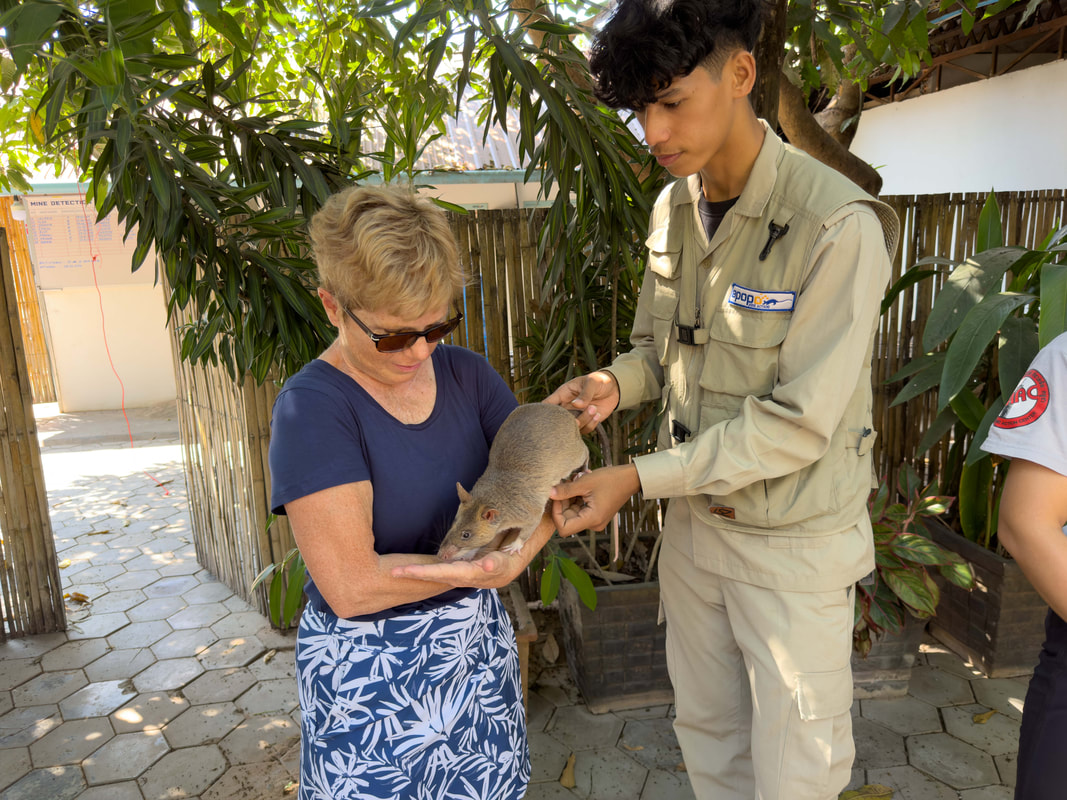
Learning about these amazing creatures brought tears to our eyes. After 'Glen' the rat gave us a demonstration of his abilities we were allowed to hold him. While he quietly snuggled in with some, he couldn't get away from me fast enough. With a sniffer like his, I'm sure he pegged me for who I was in the animal loving department :)
Cambodia was a slow burn for us and by the end we were enamored. It started out in the less developed east and then the pace gradually picked up in the south and up the west side. Because tourism is still young, we loved the authentic experiences (pardon the overused expression) and friendliness of the people. So often we read or were told that a place we would stay at or experience we paid for was a training ground for younger people to work in the hospitality or tourism business while they learned English. With 65% of Cambodians under 30, there are a lot of young people who need jobs, in part to help support their families living and farming in rural areas.
